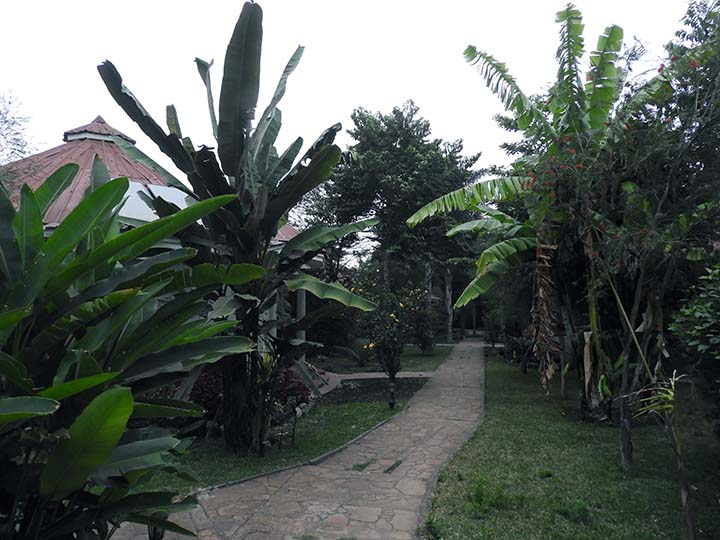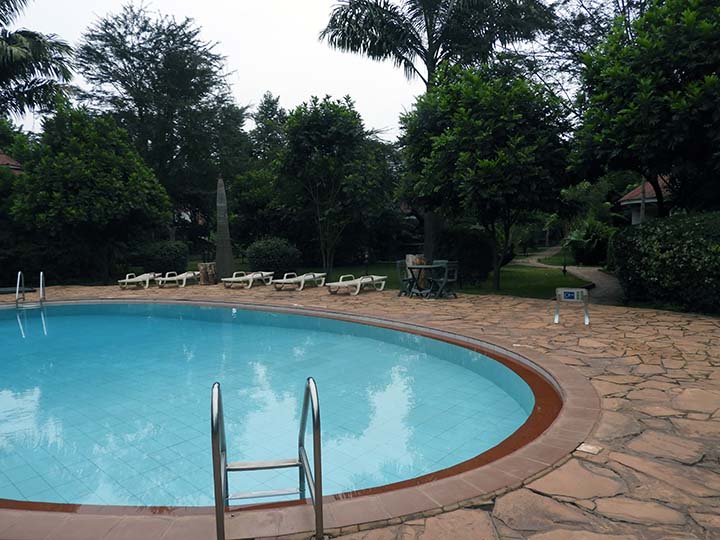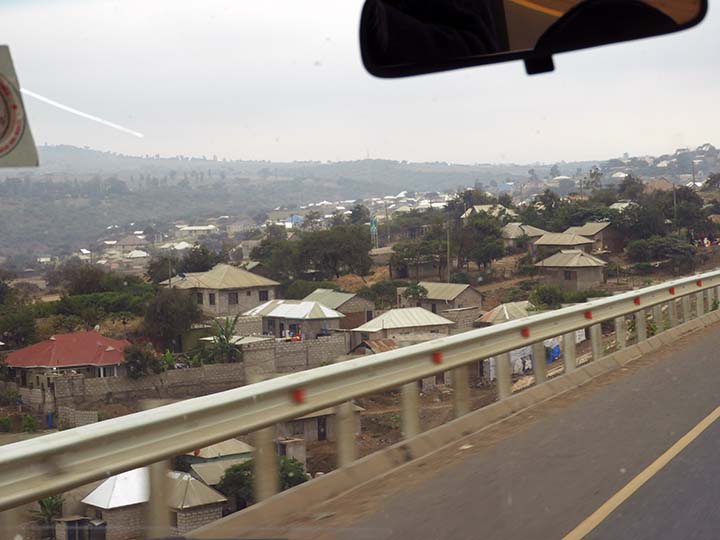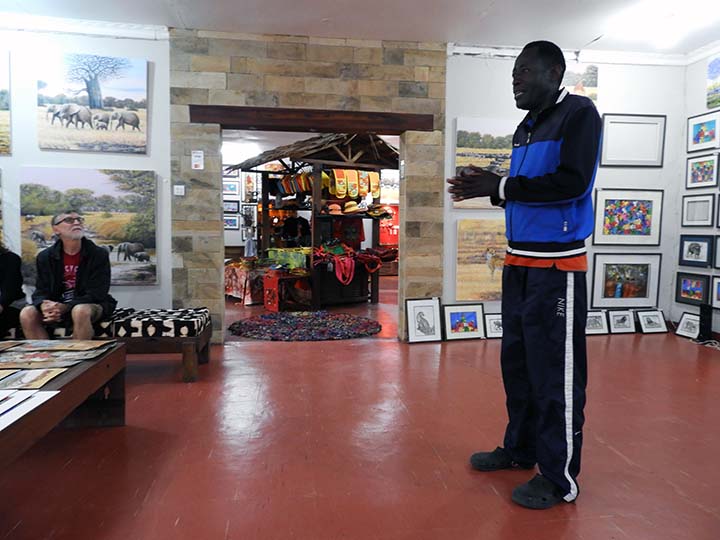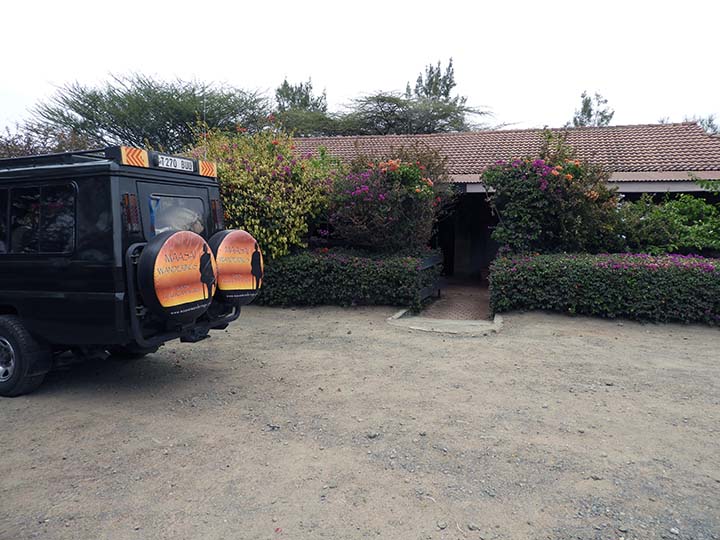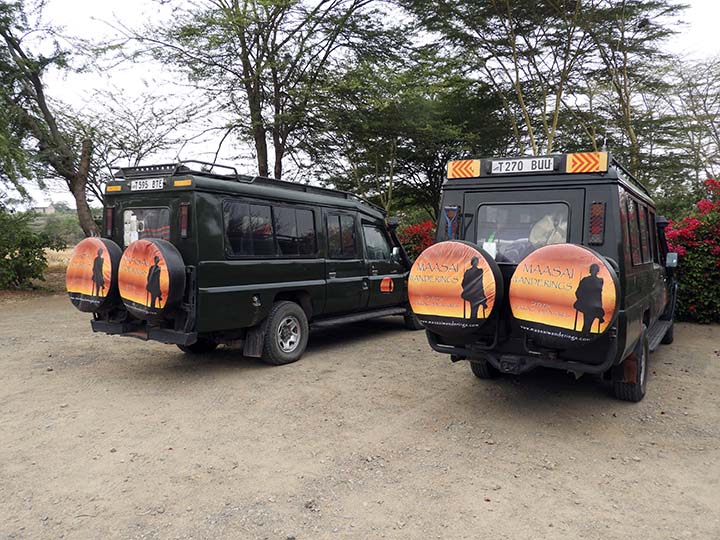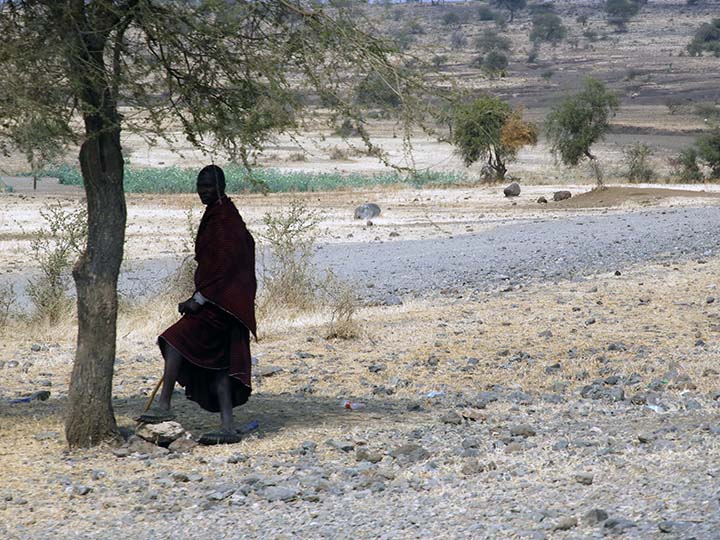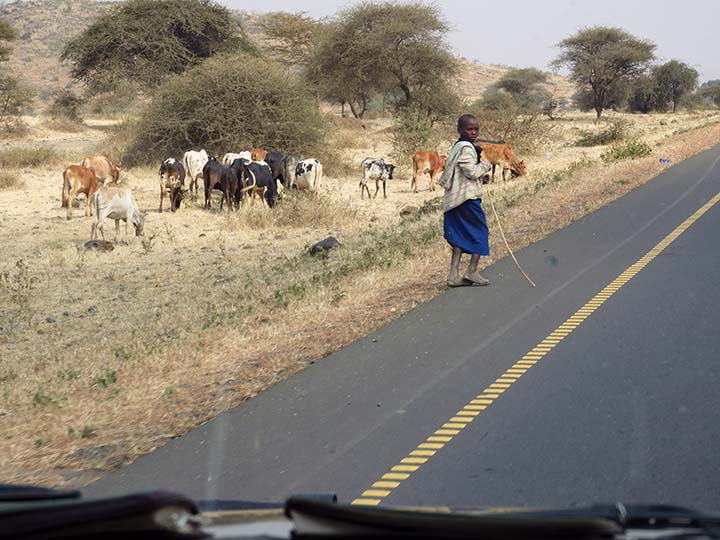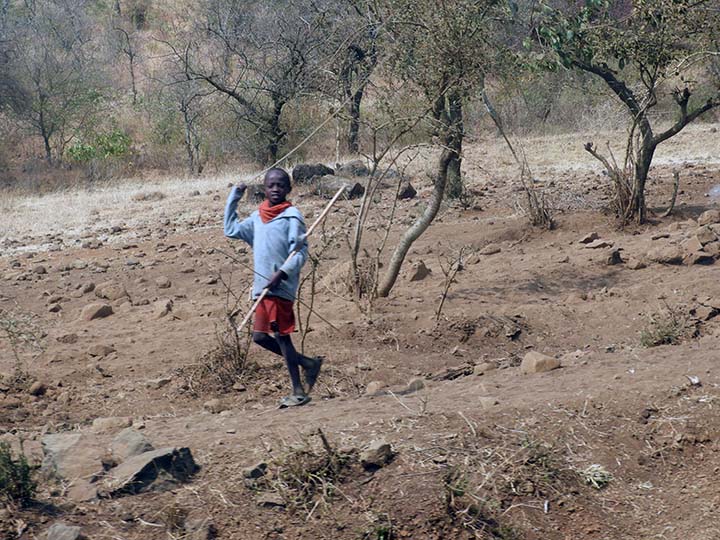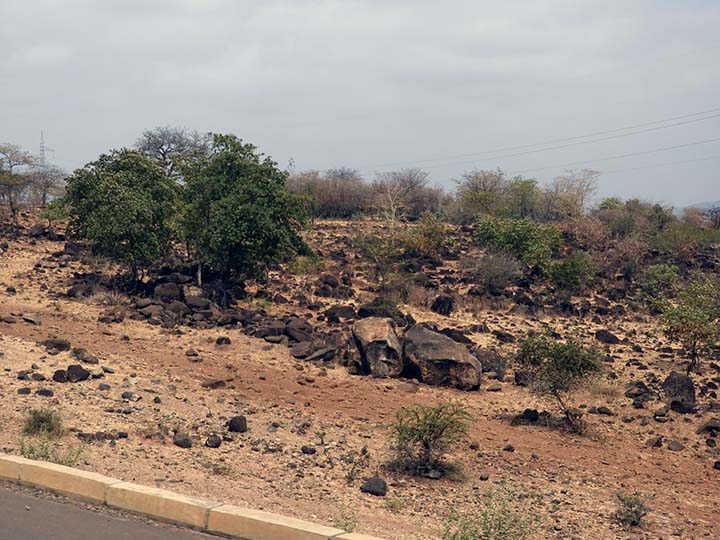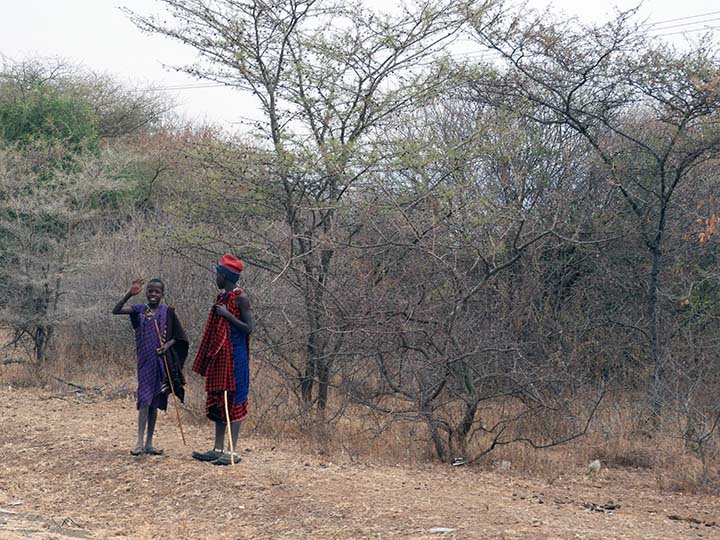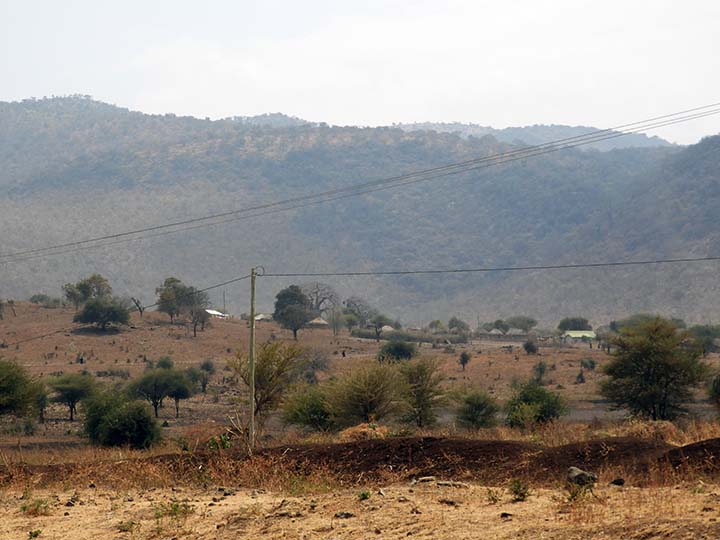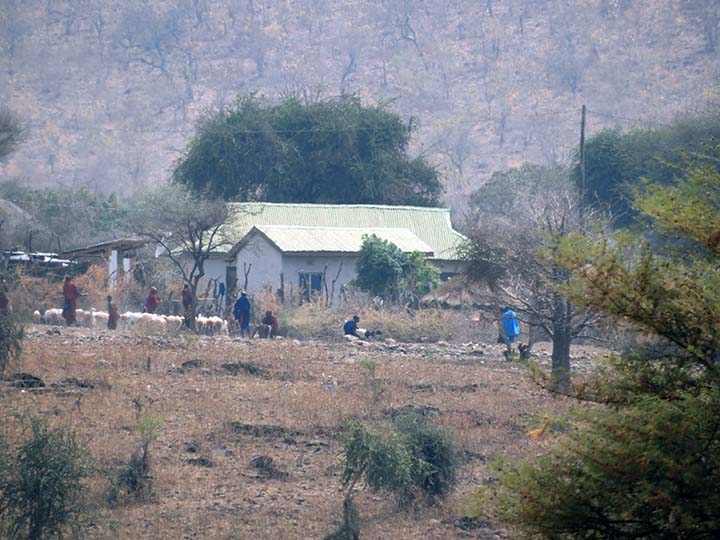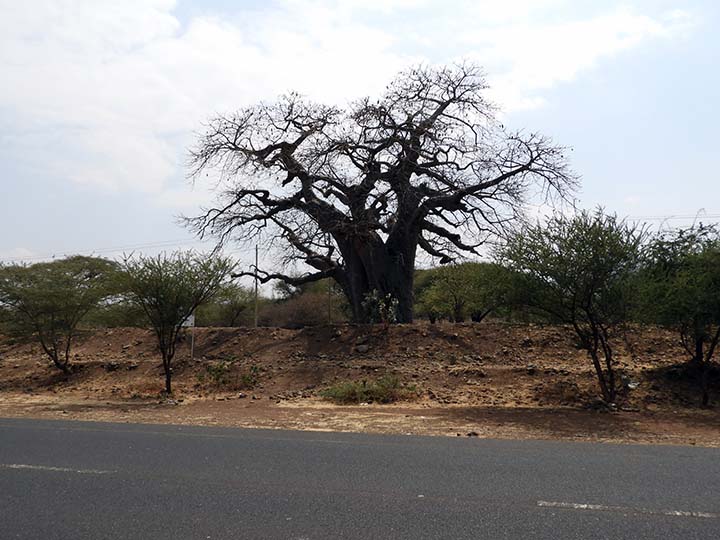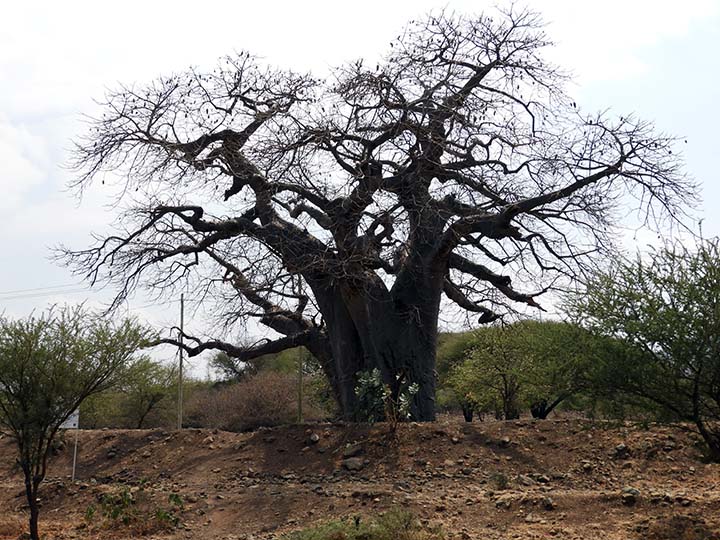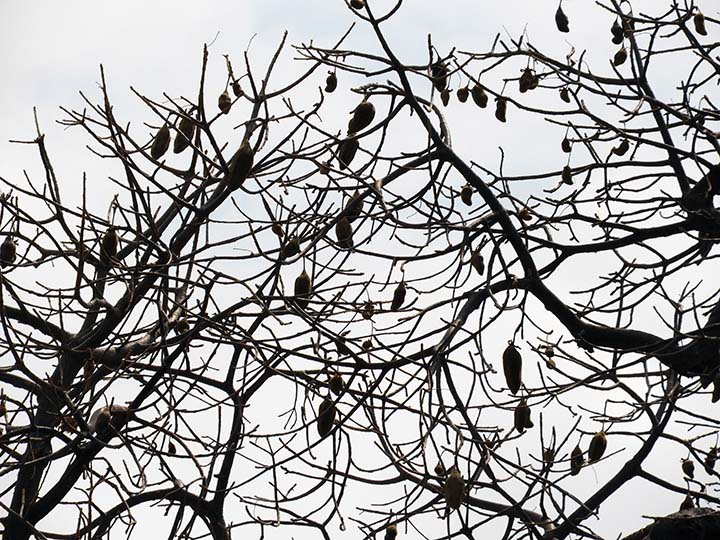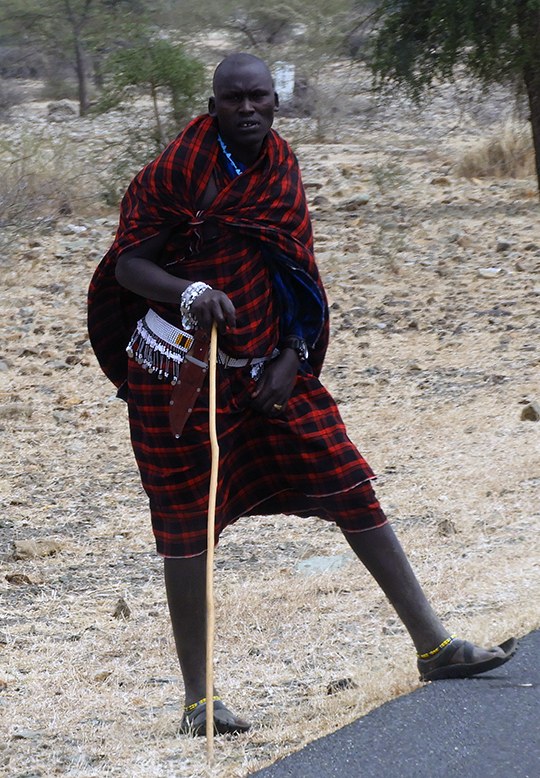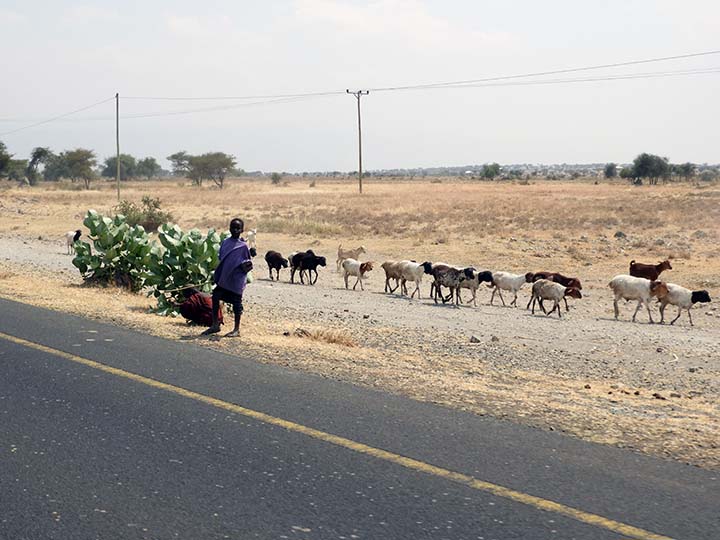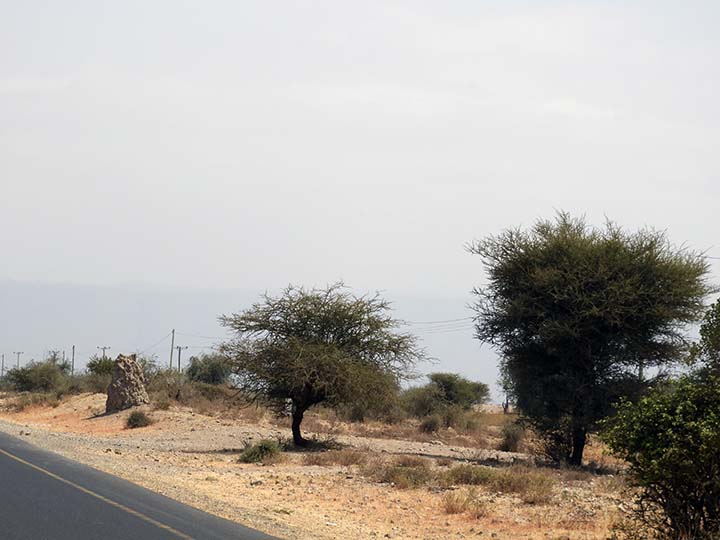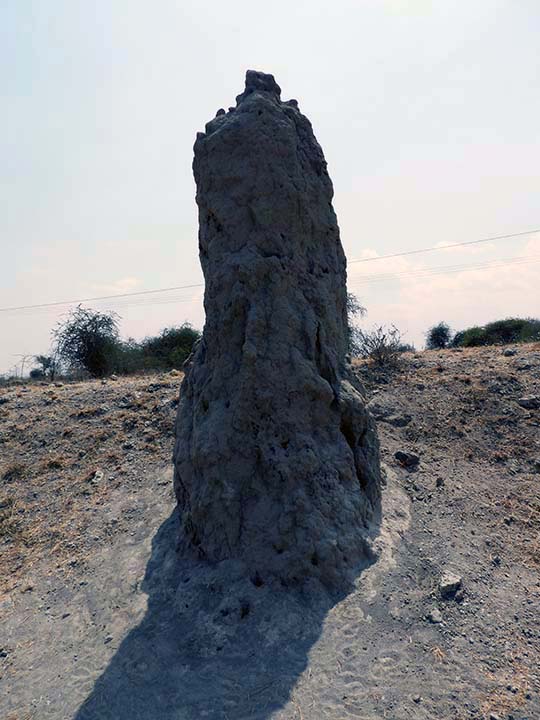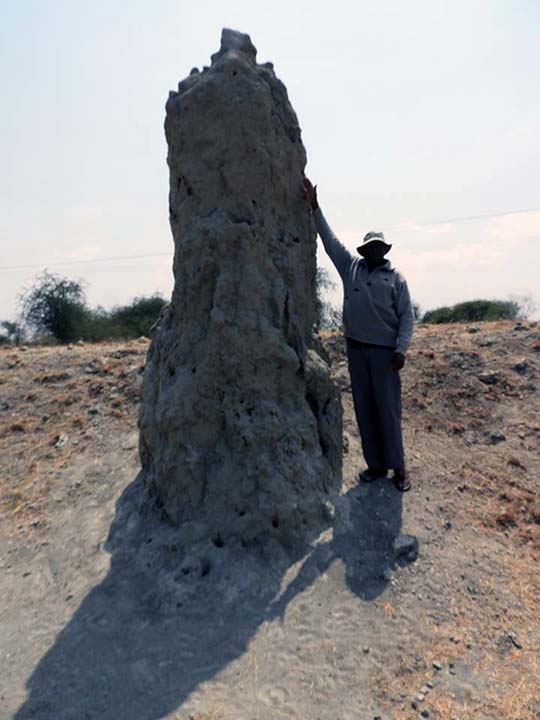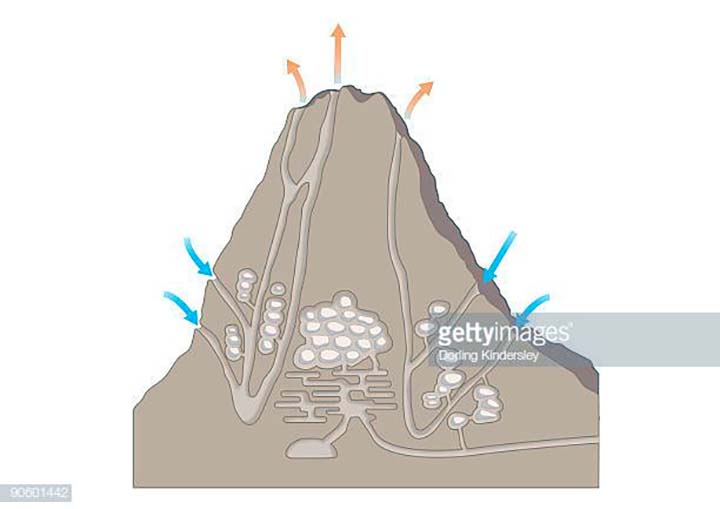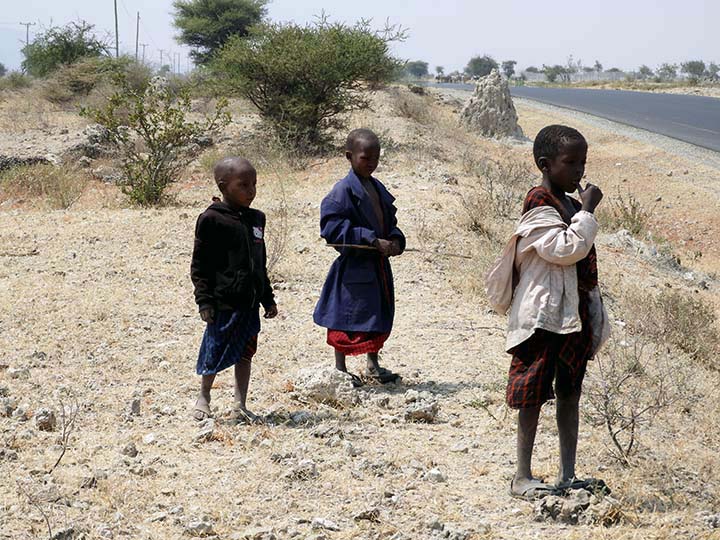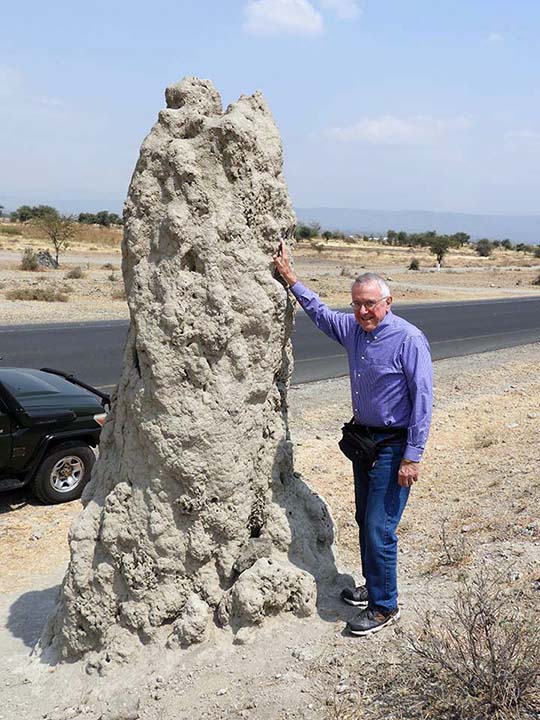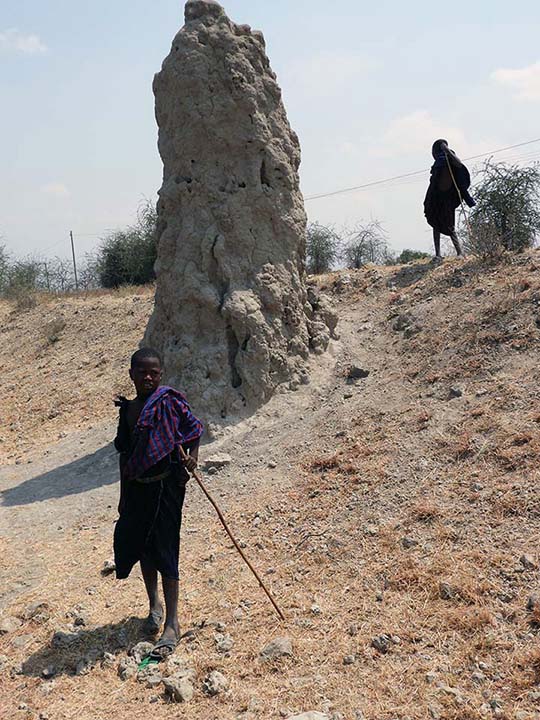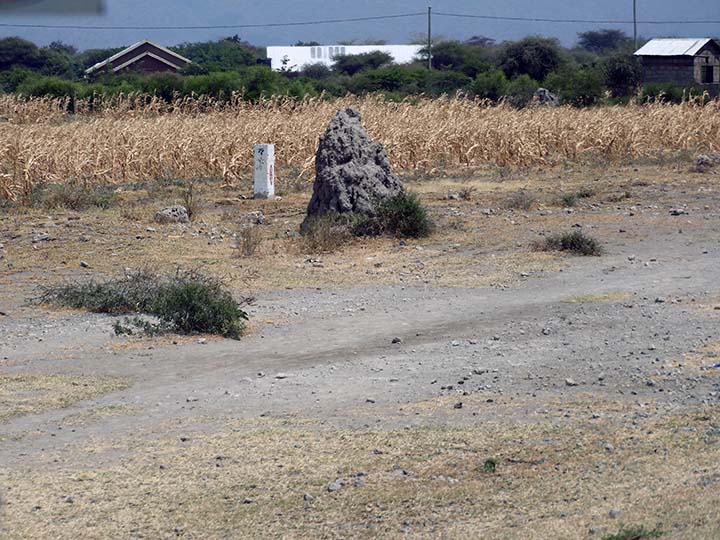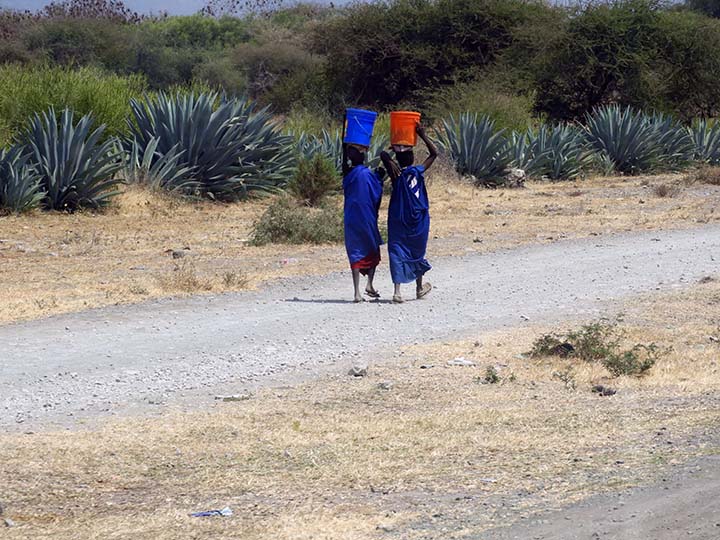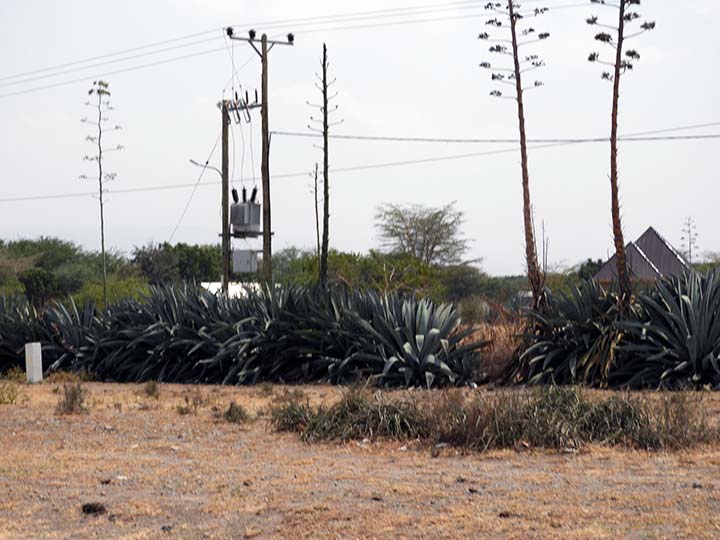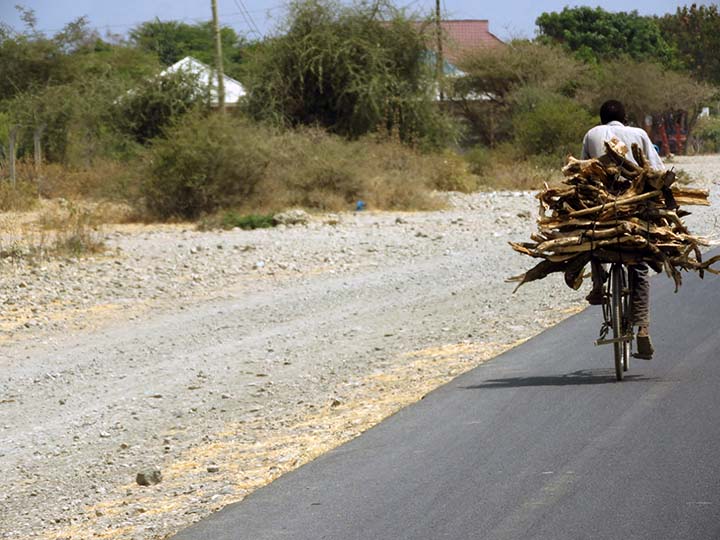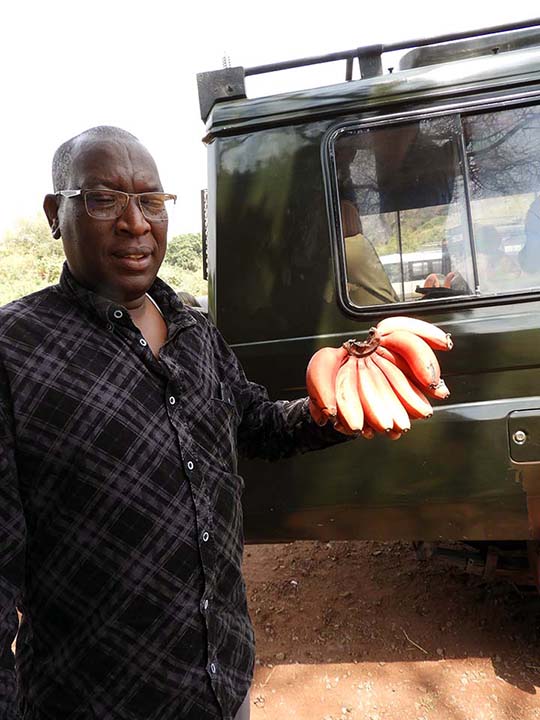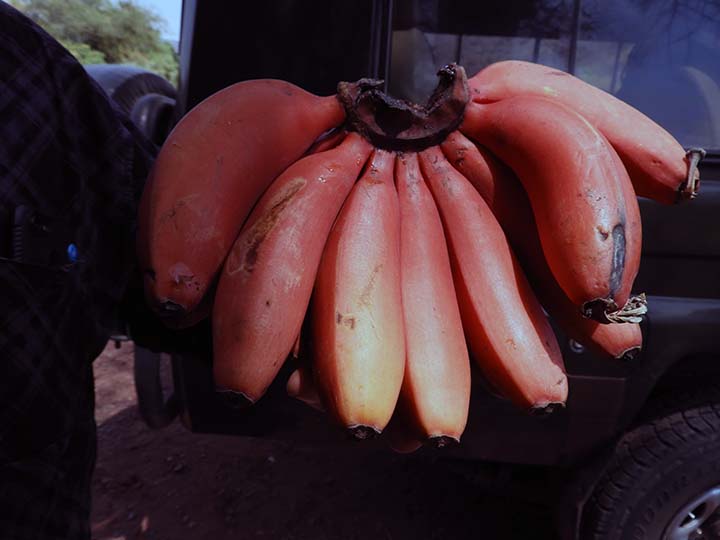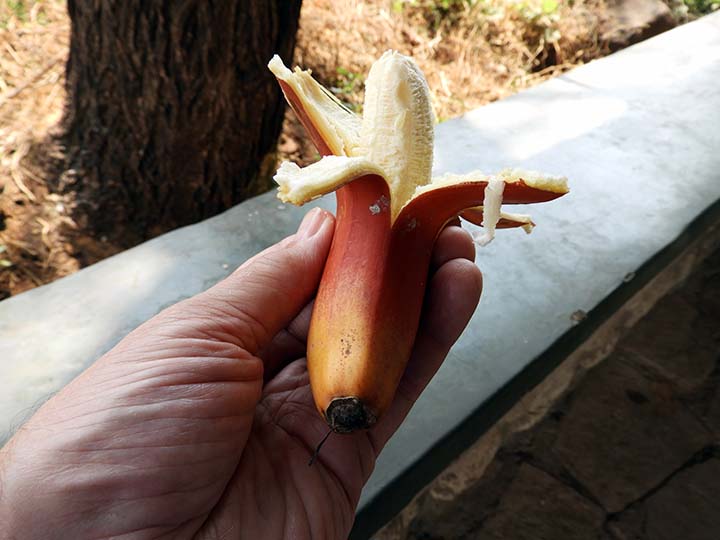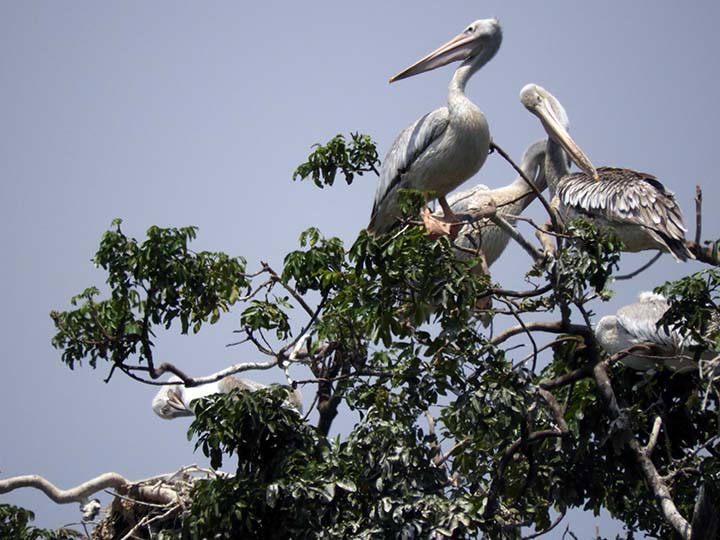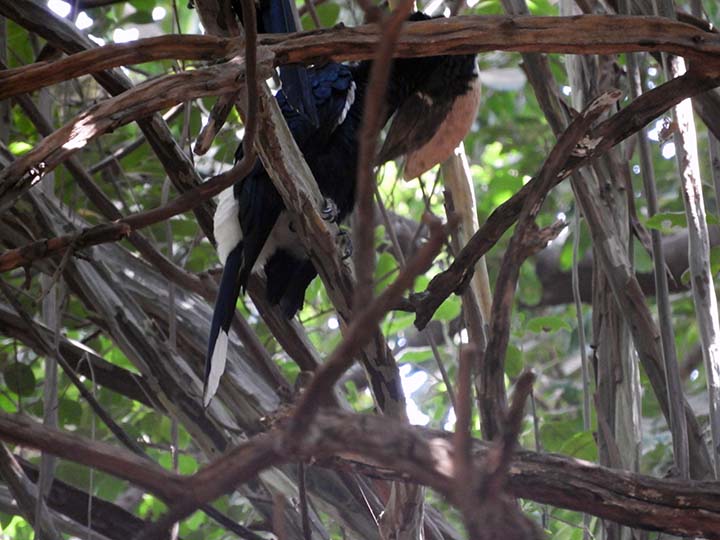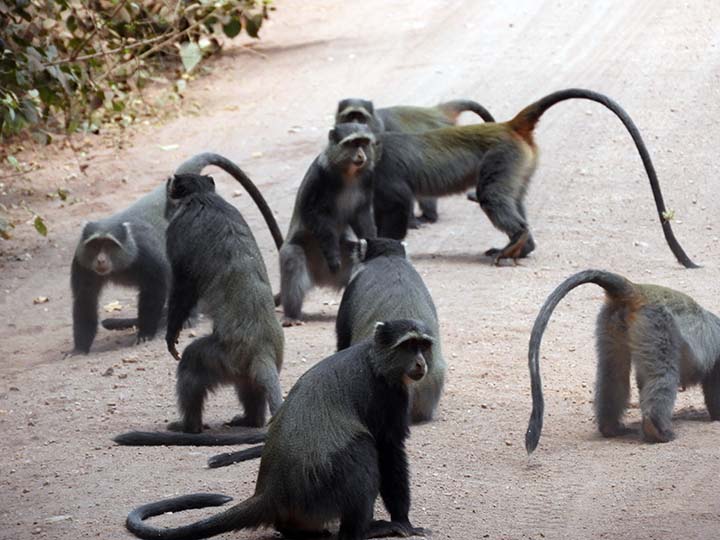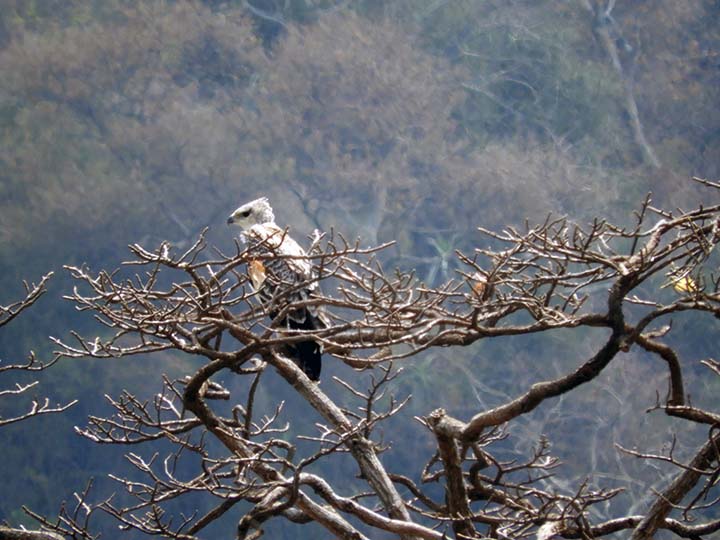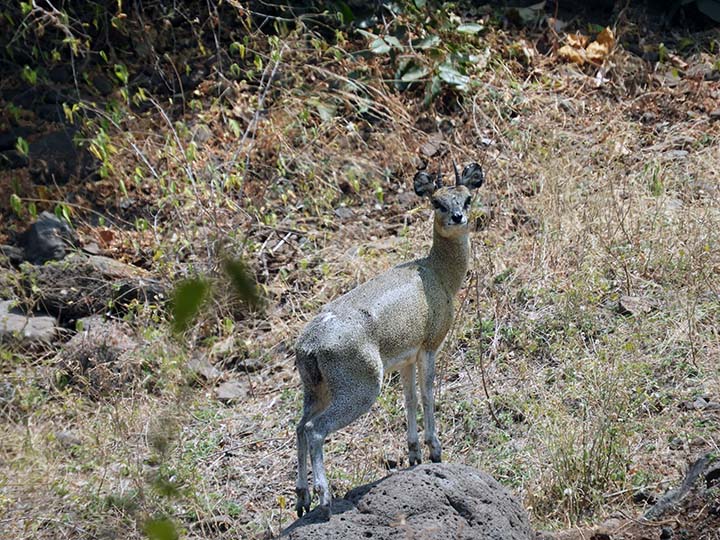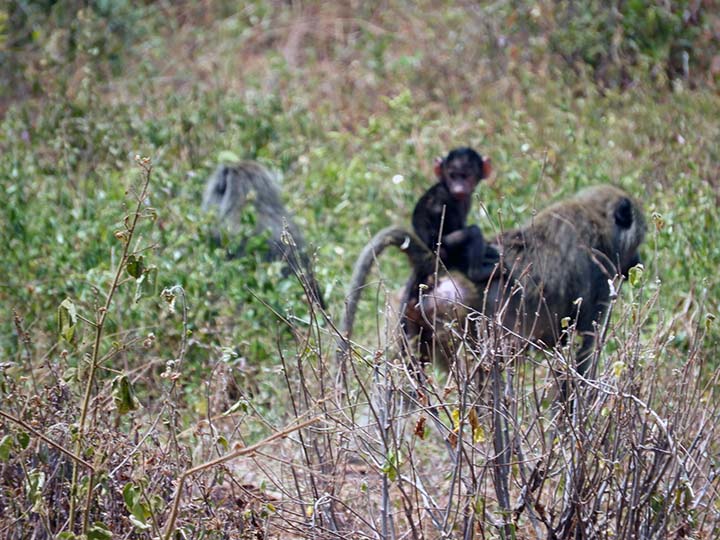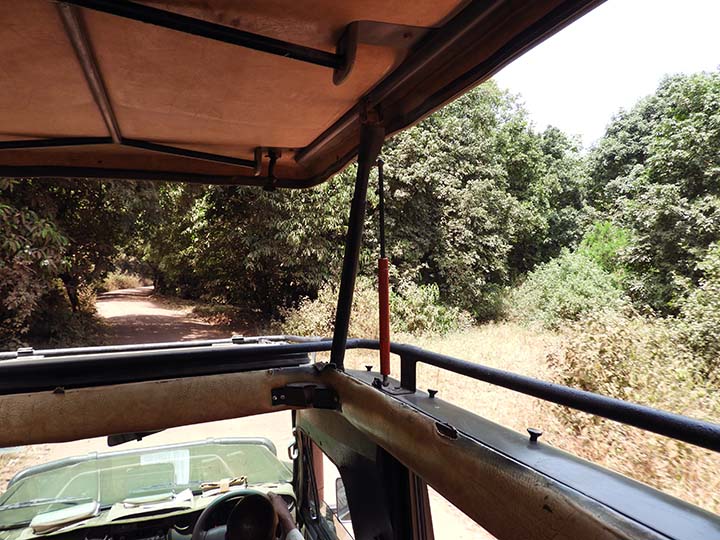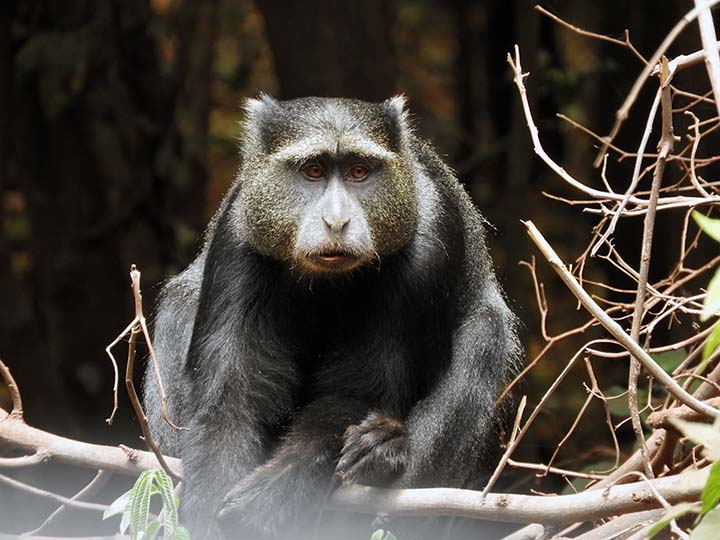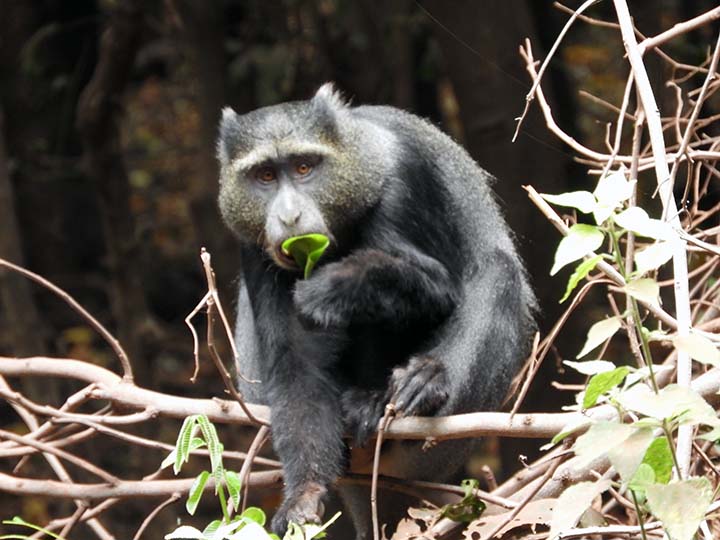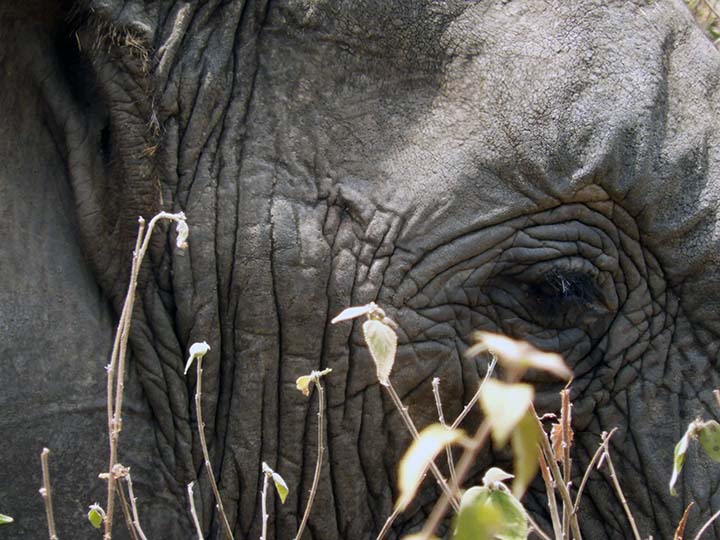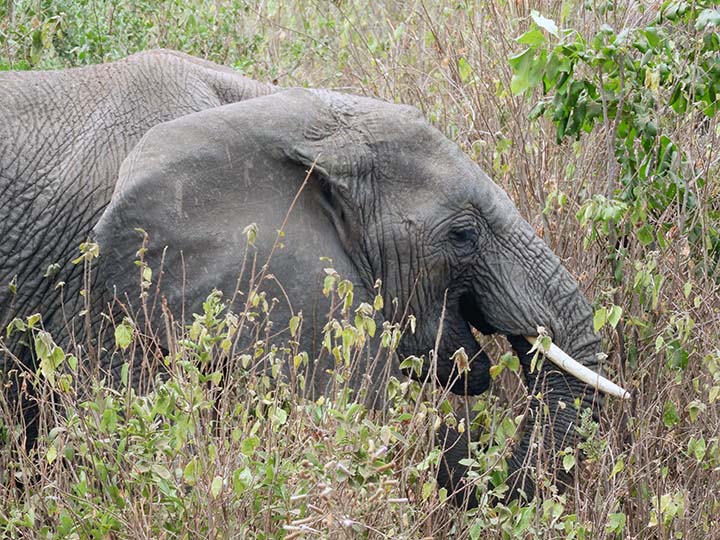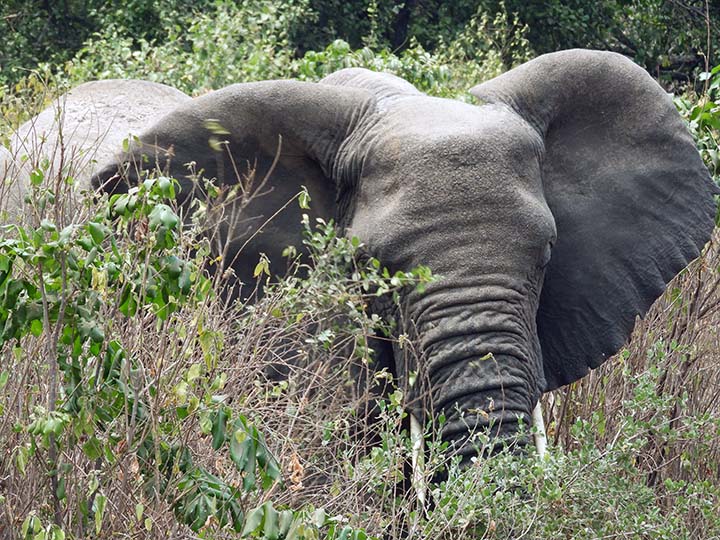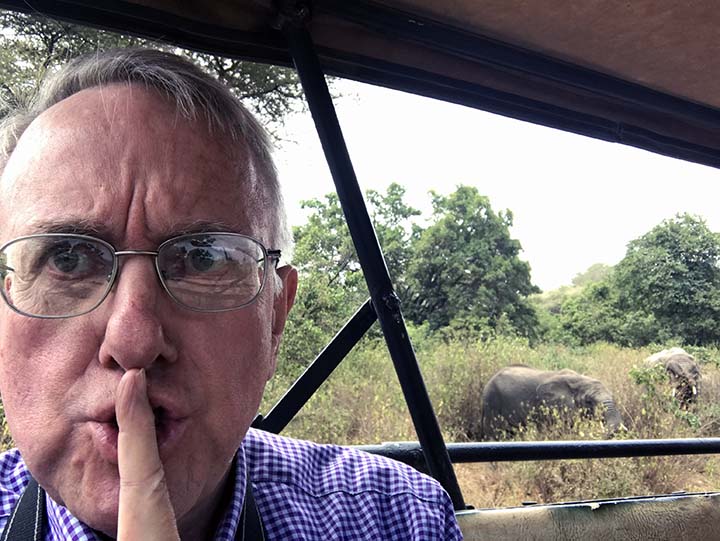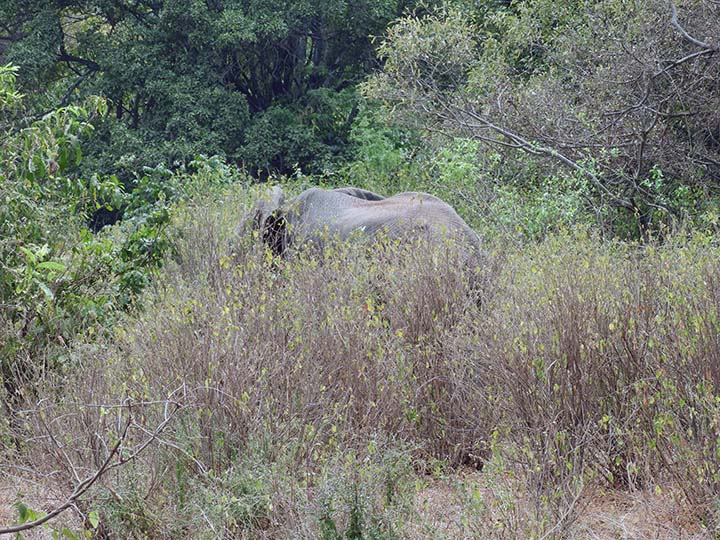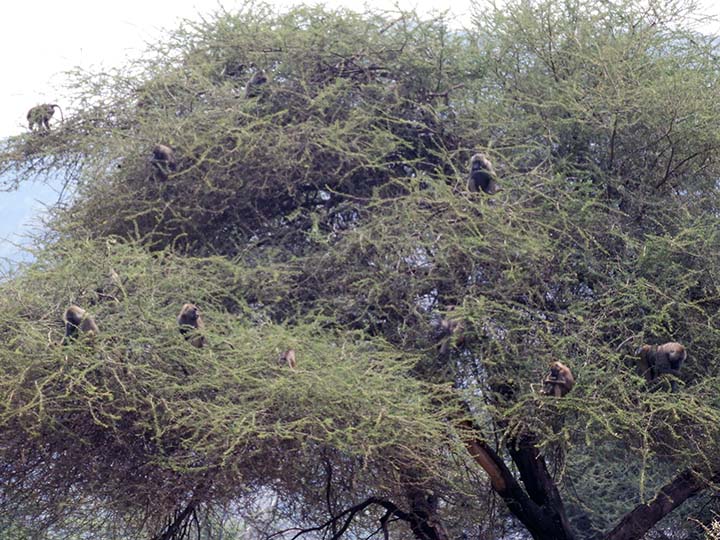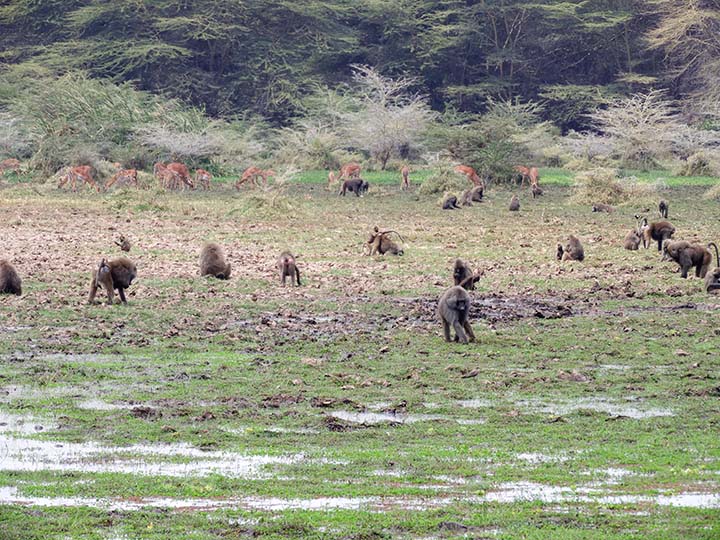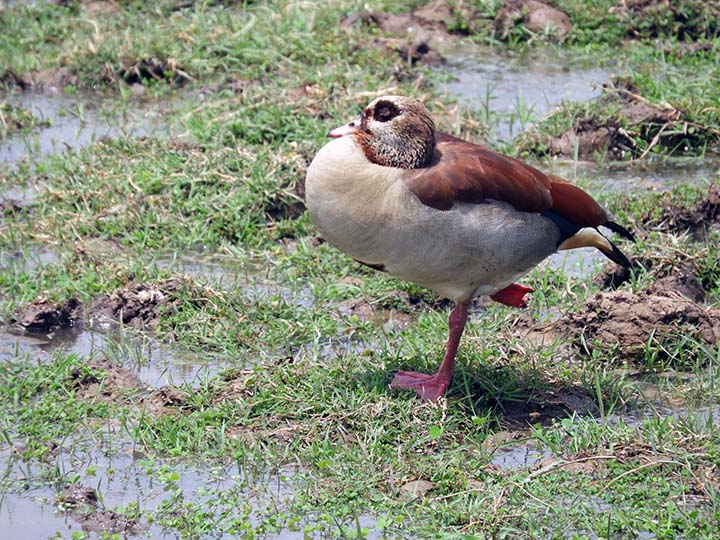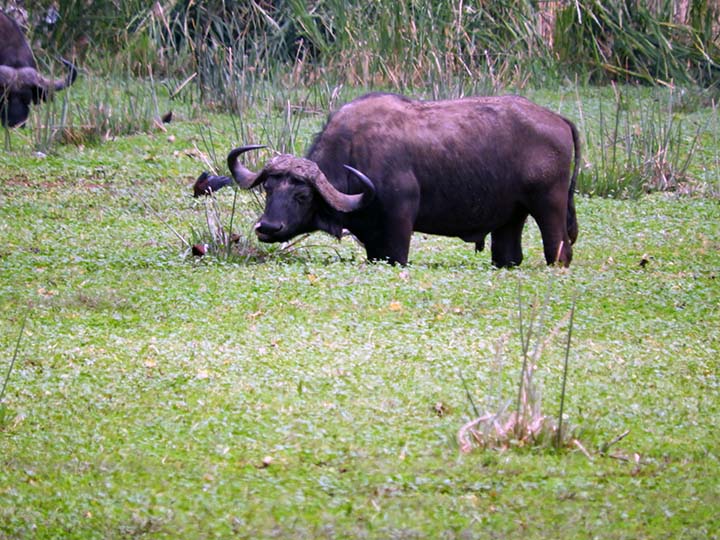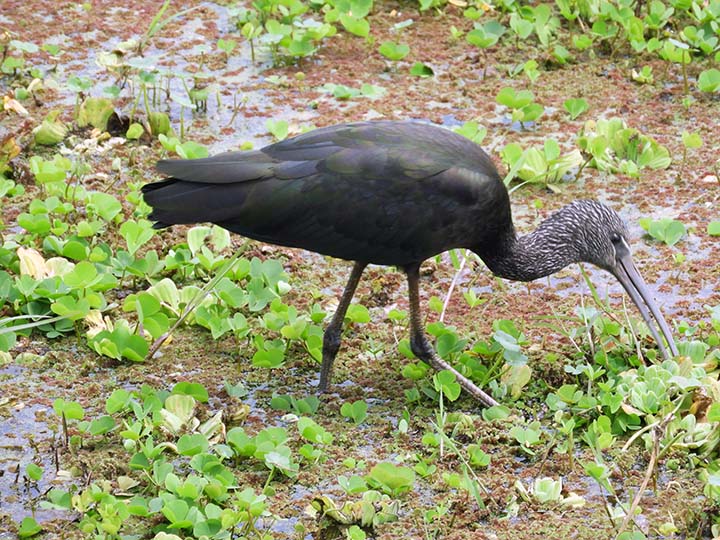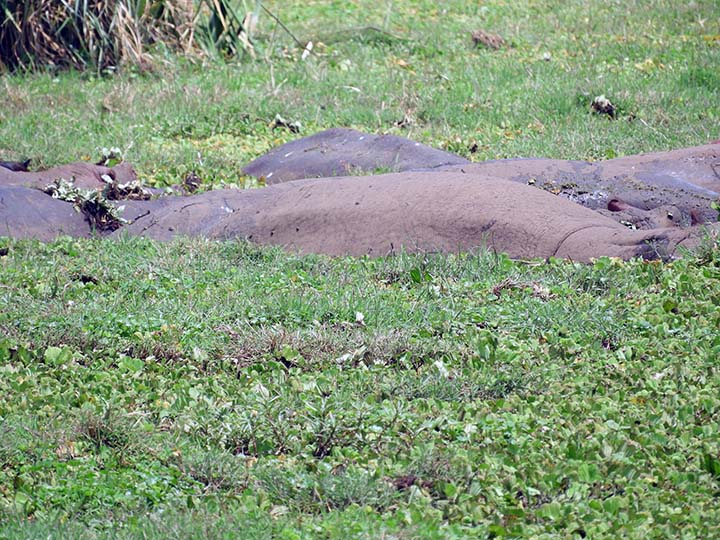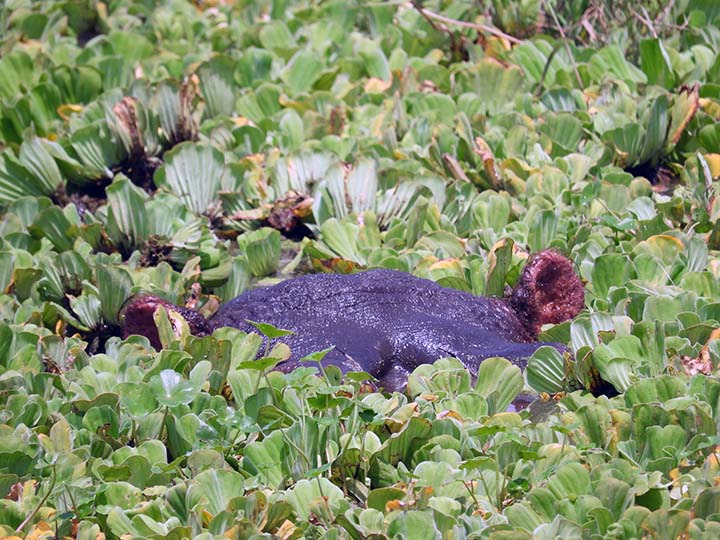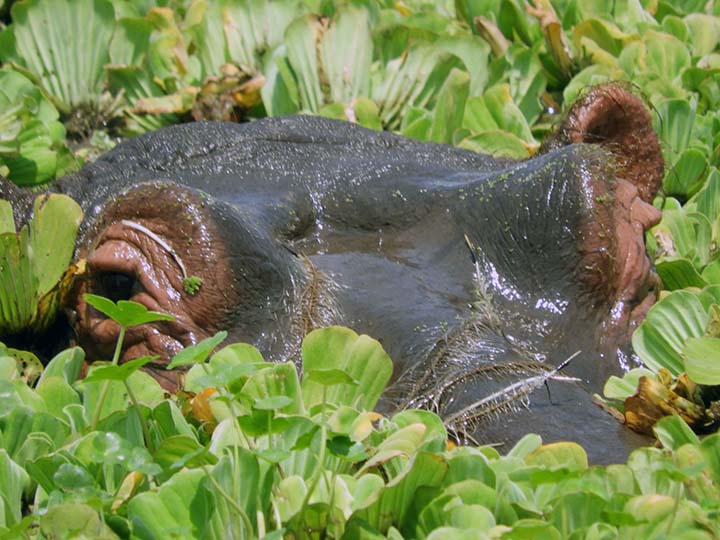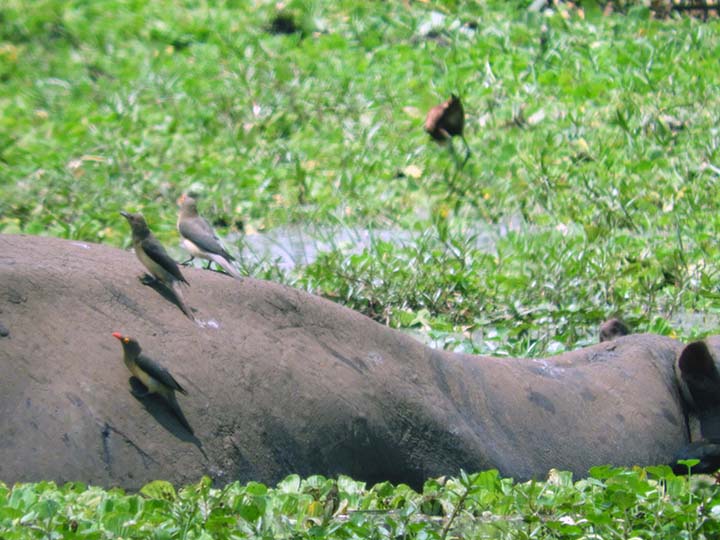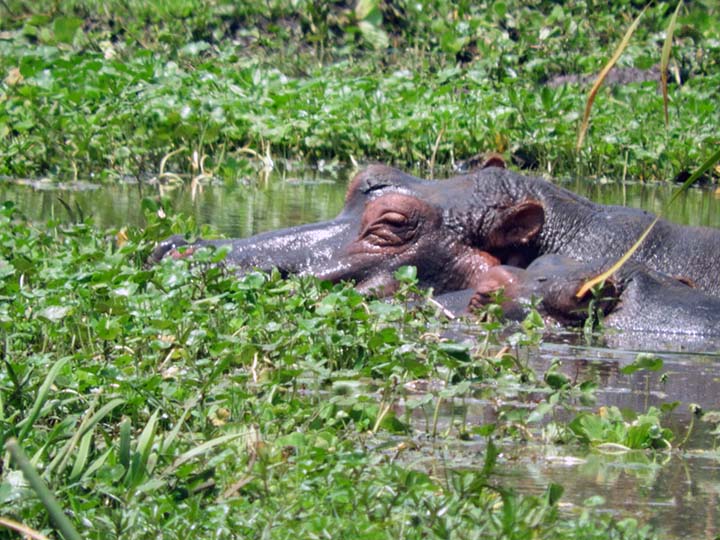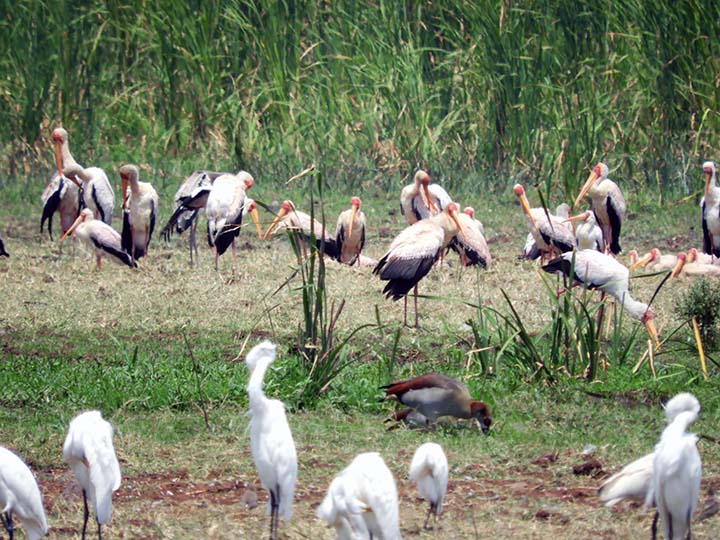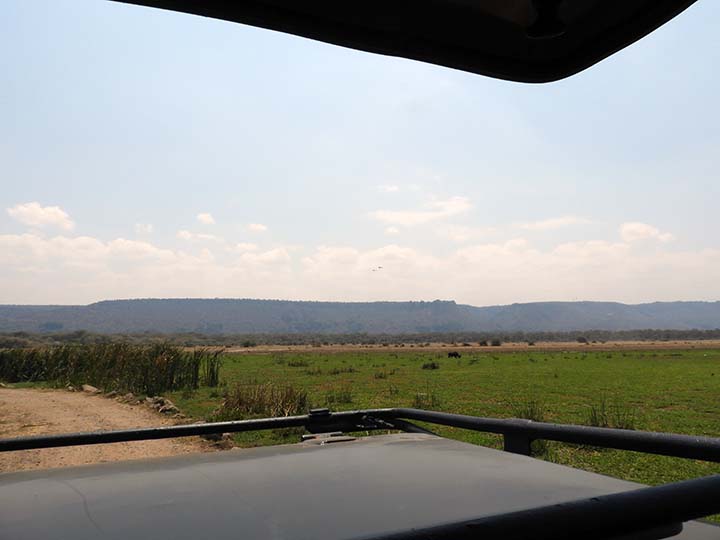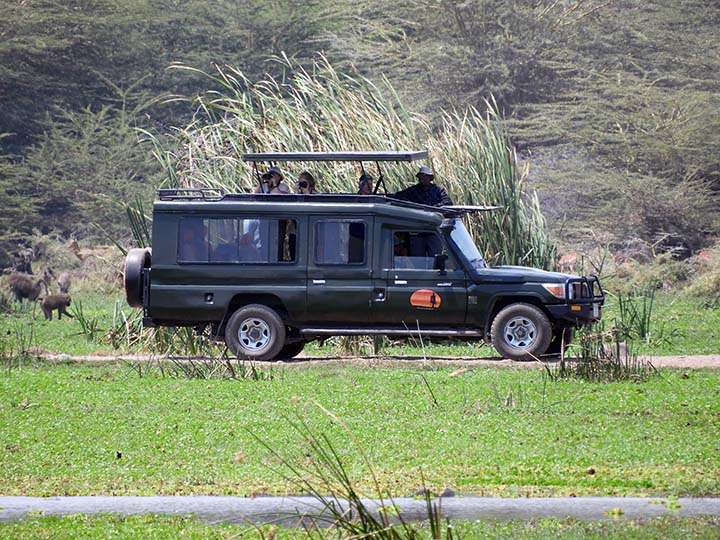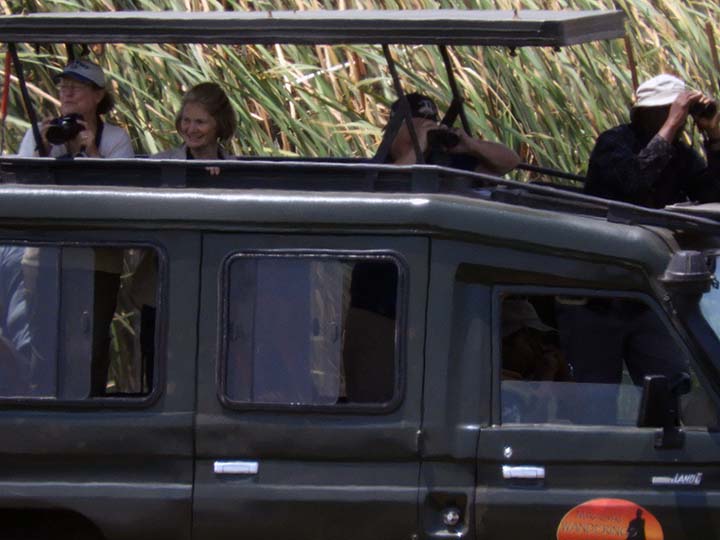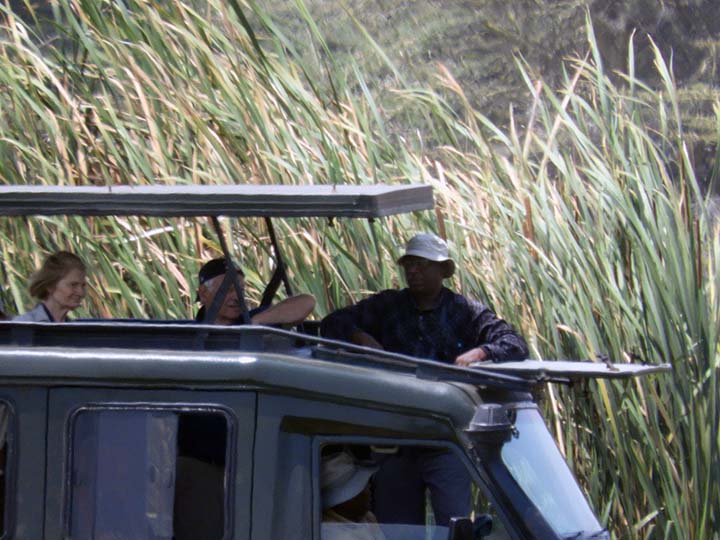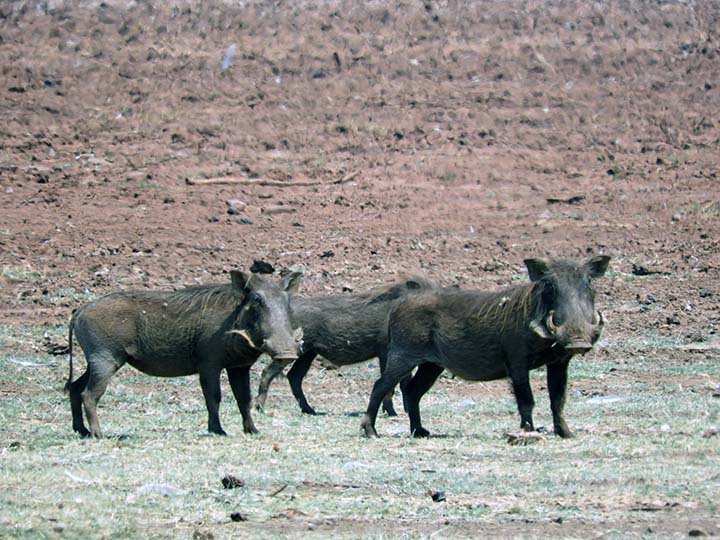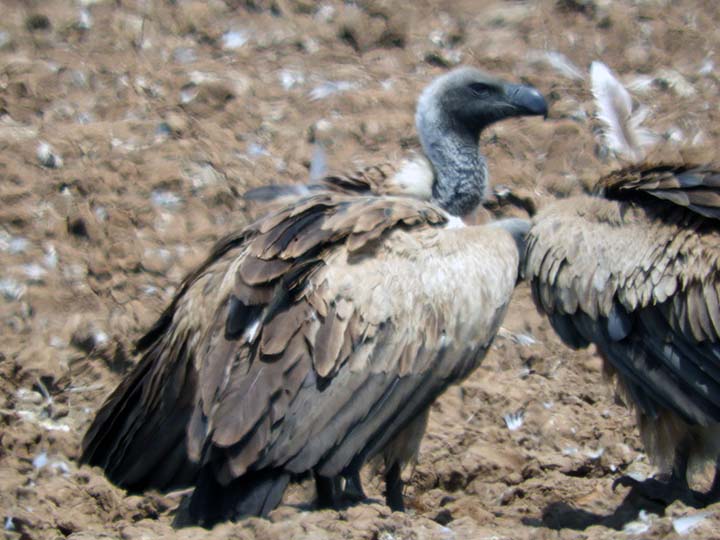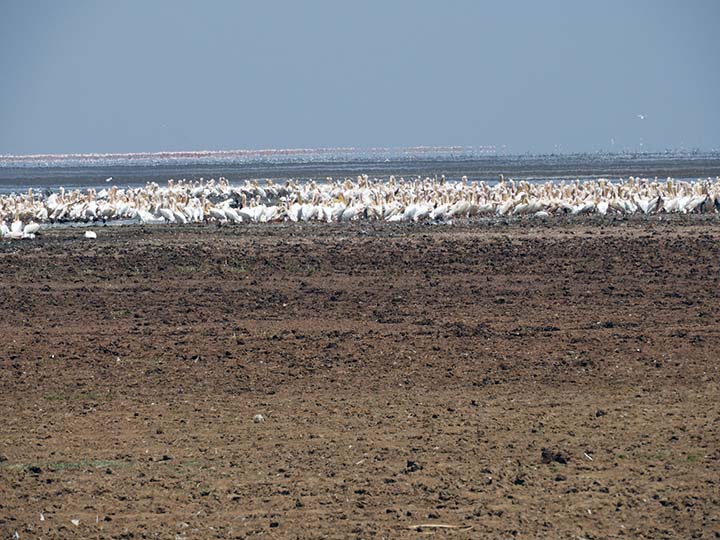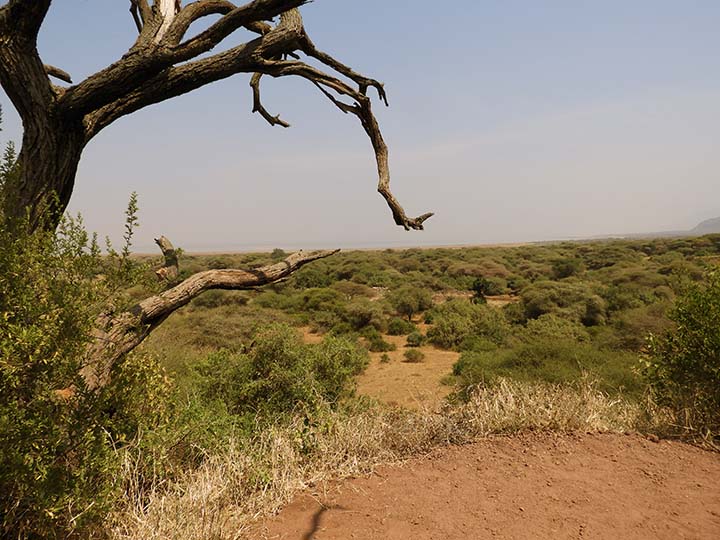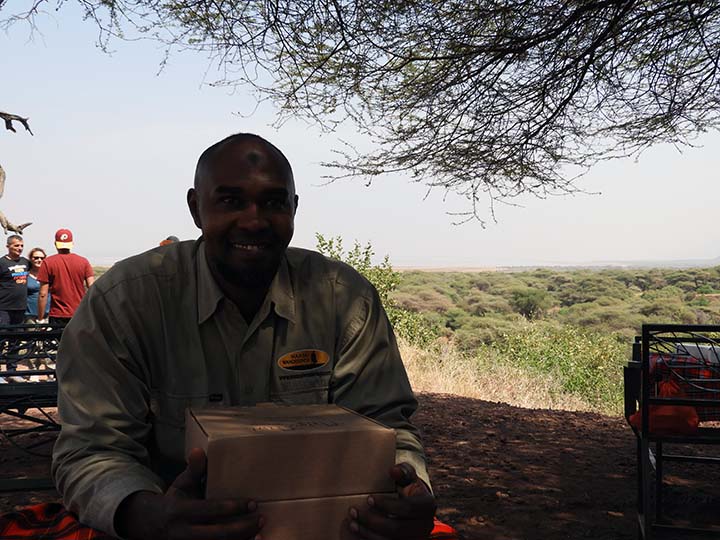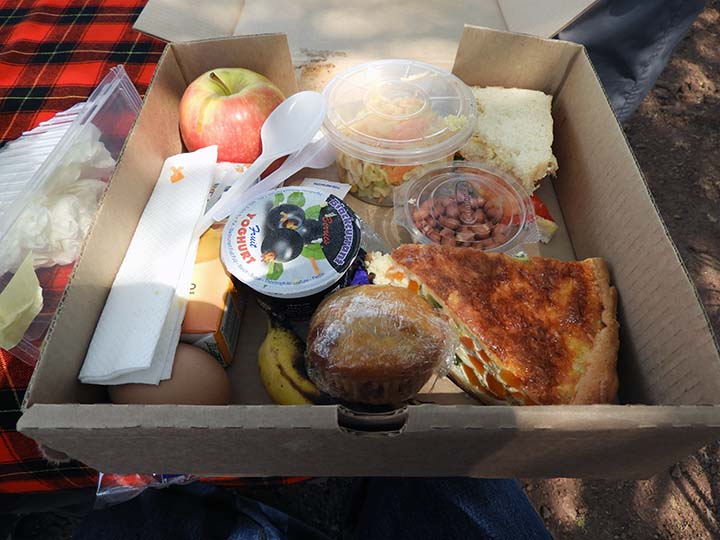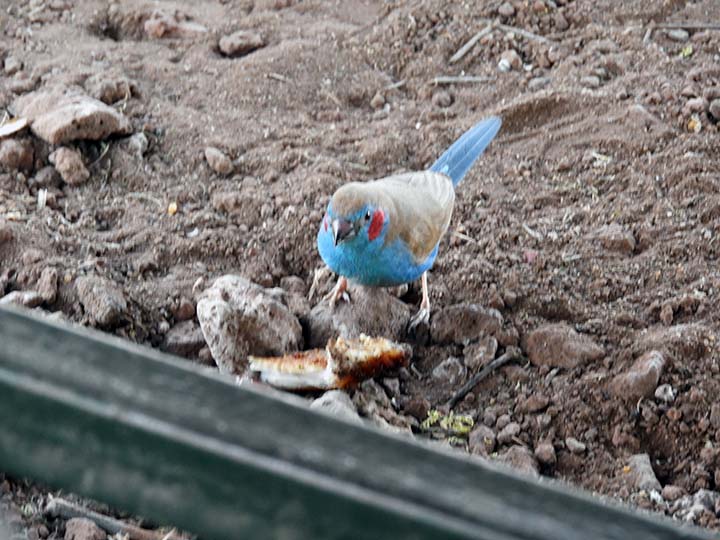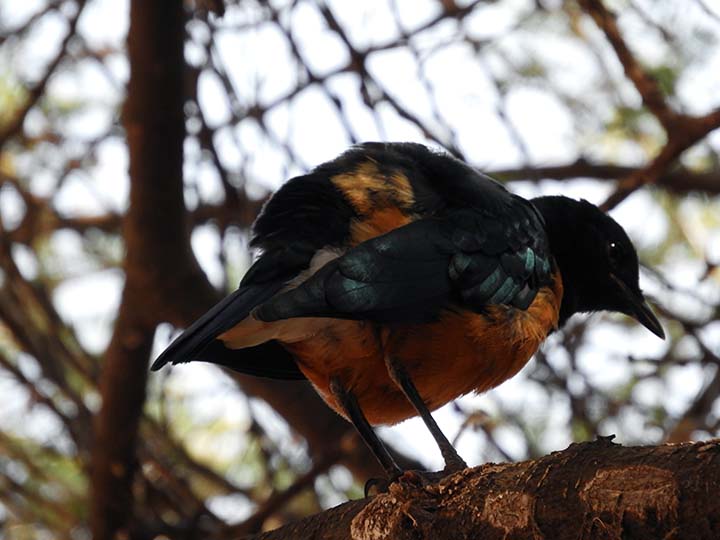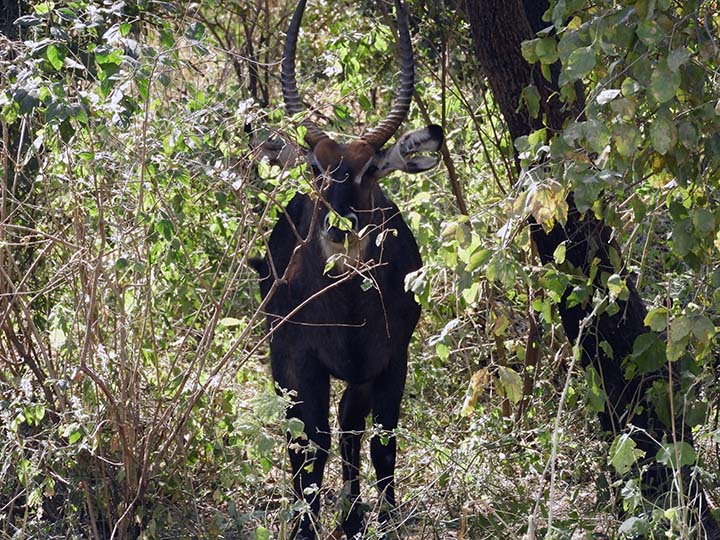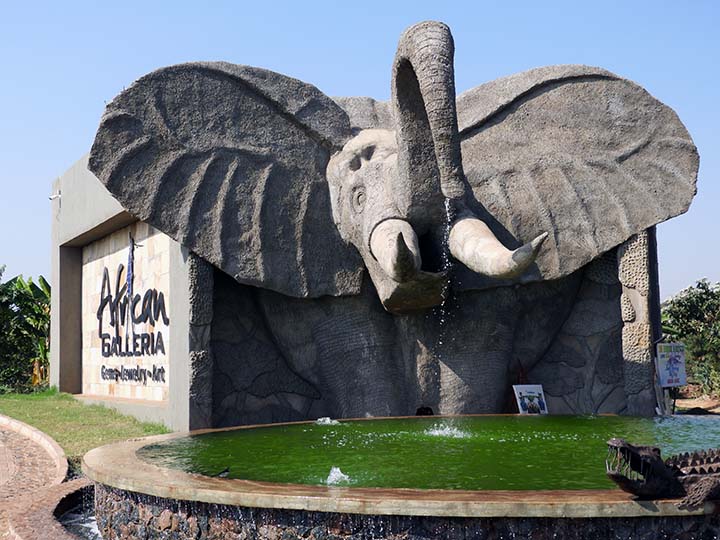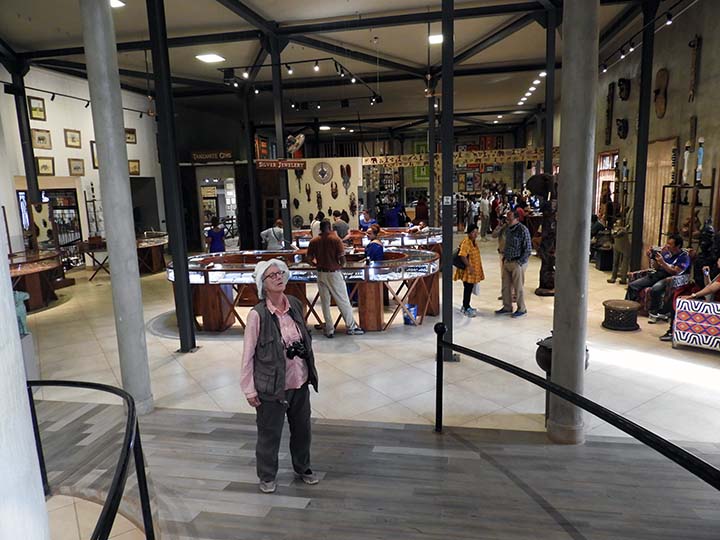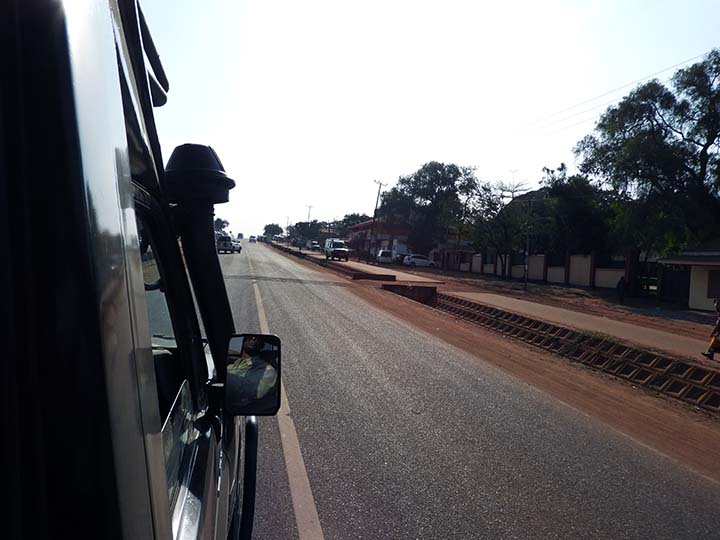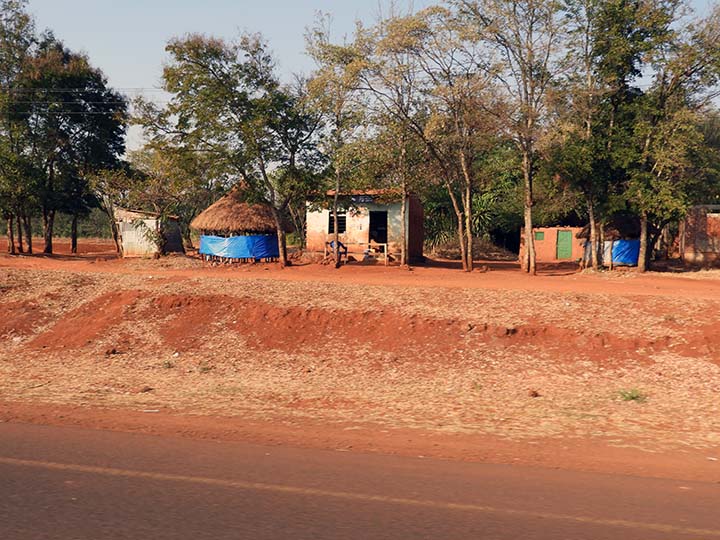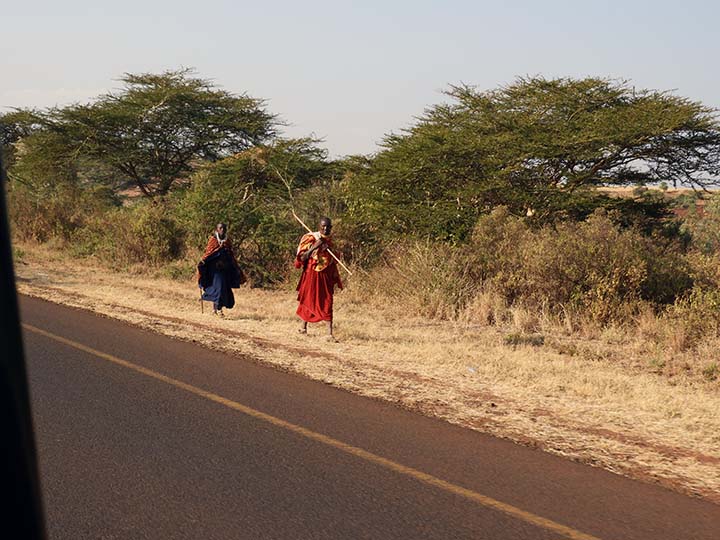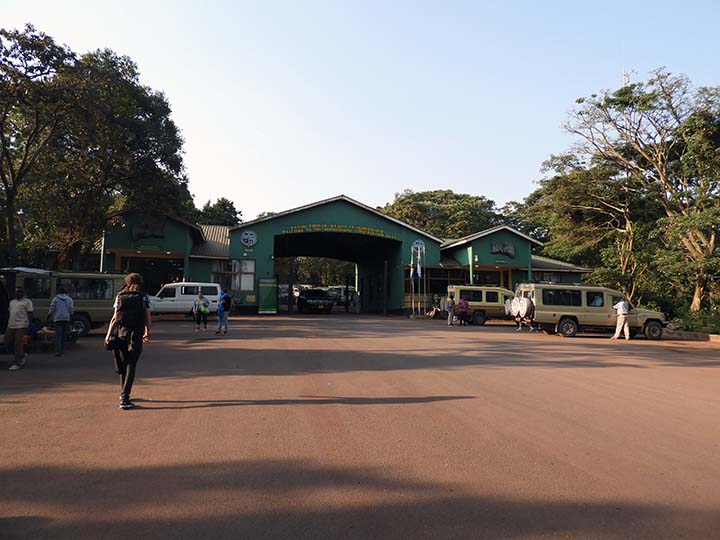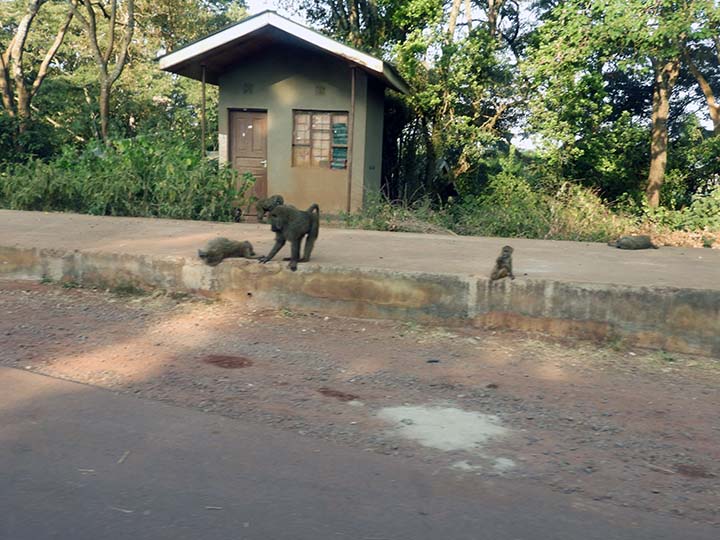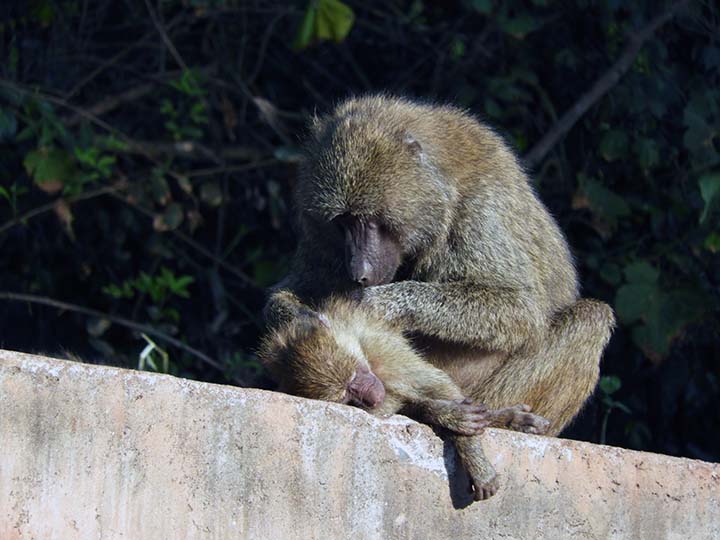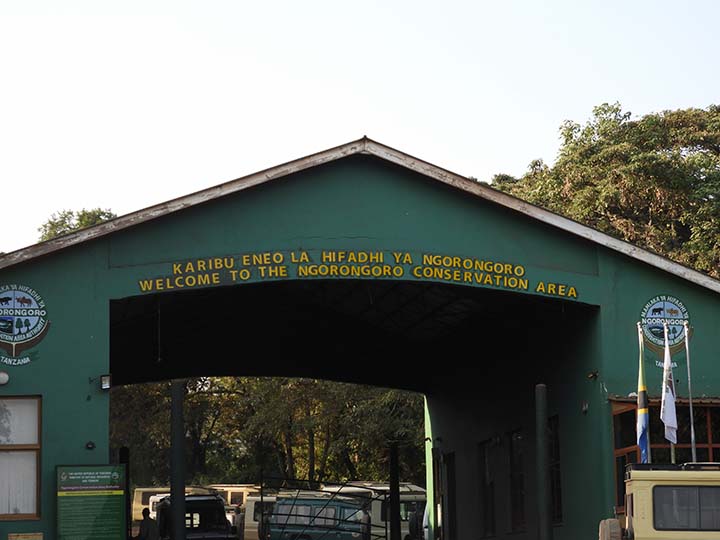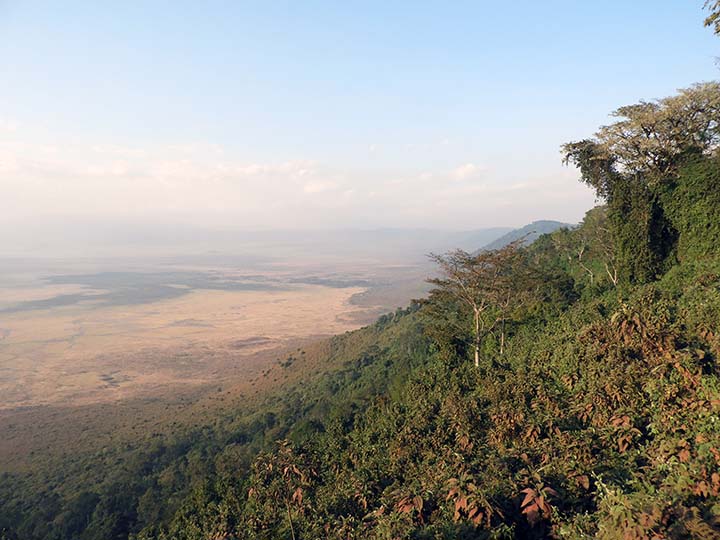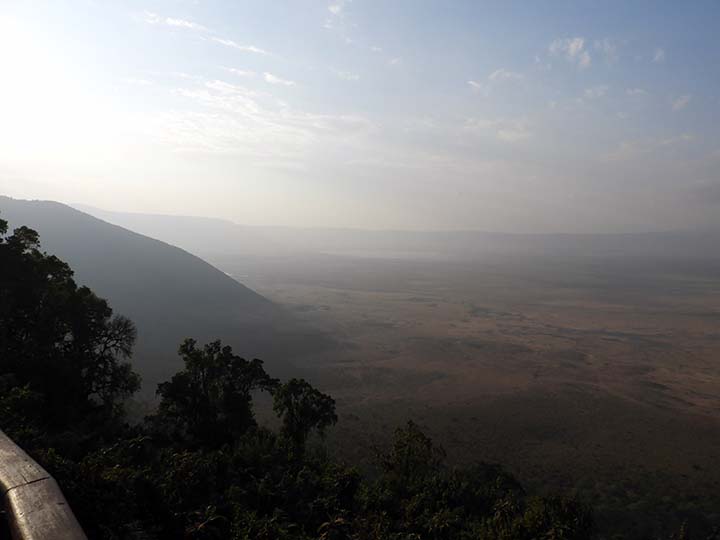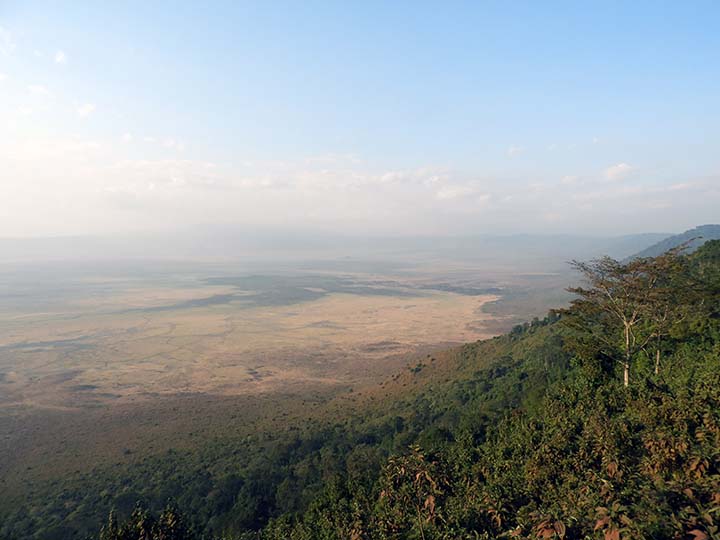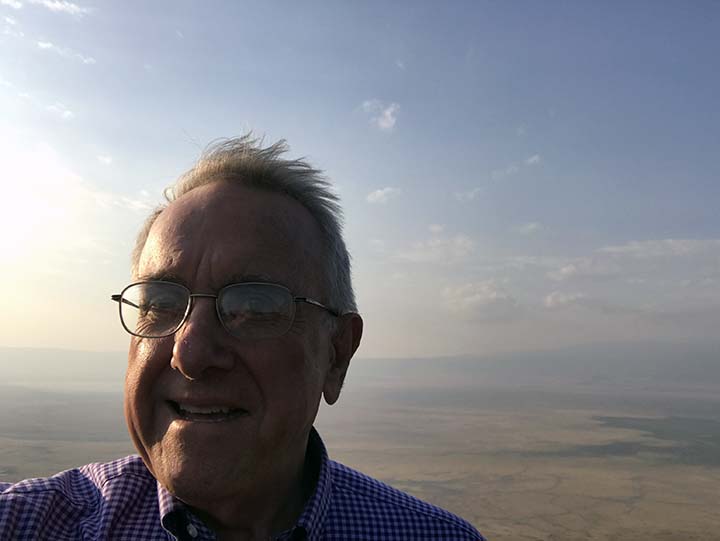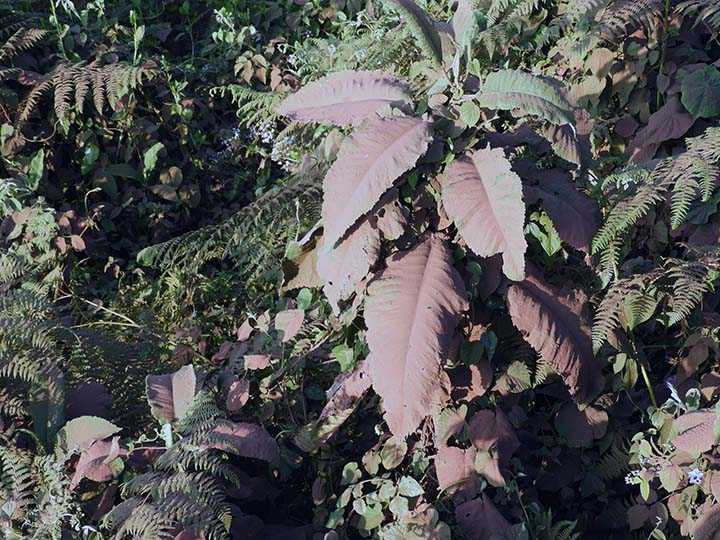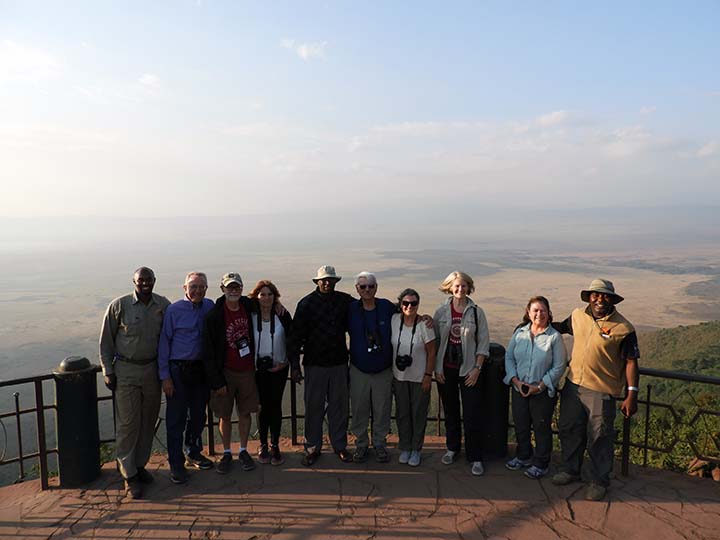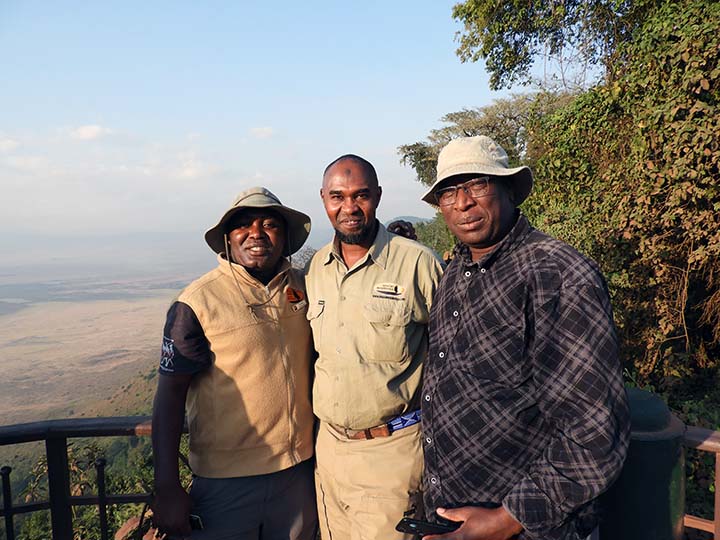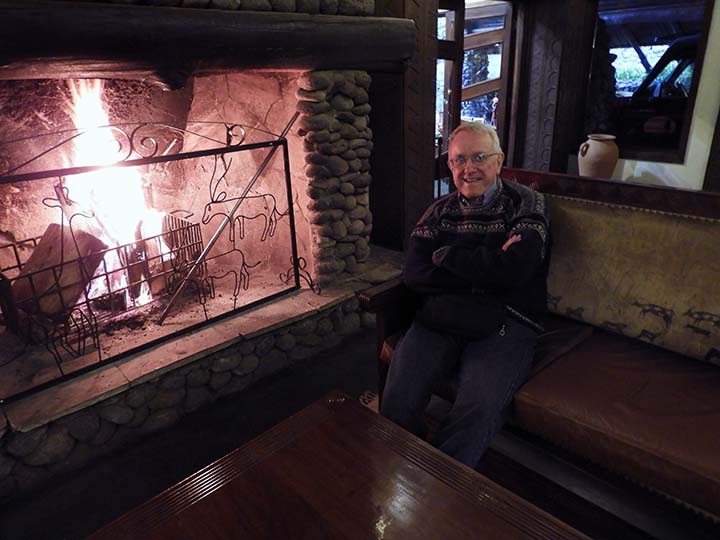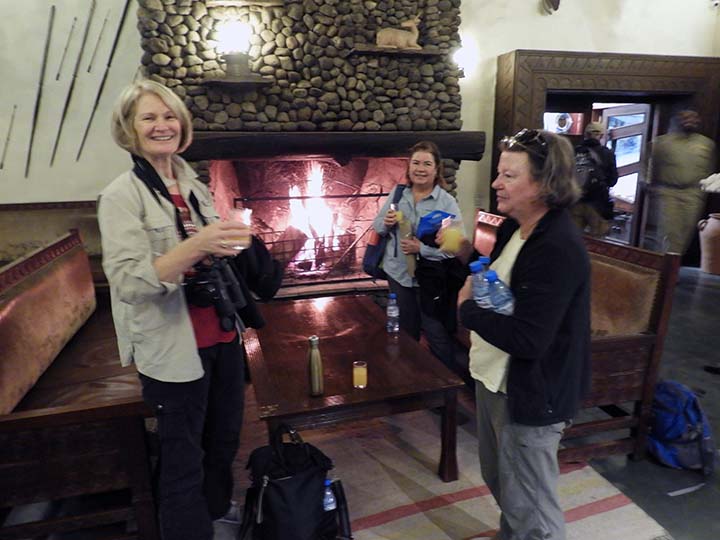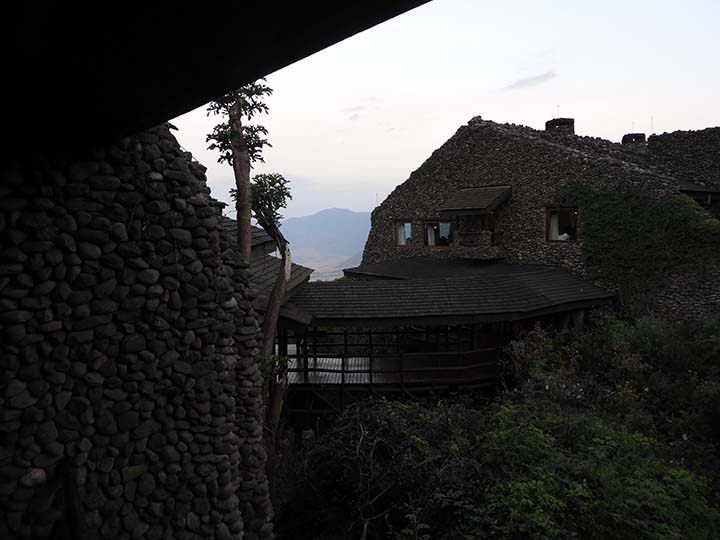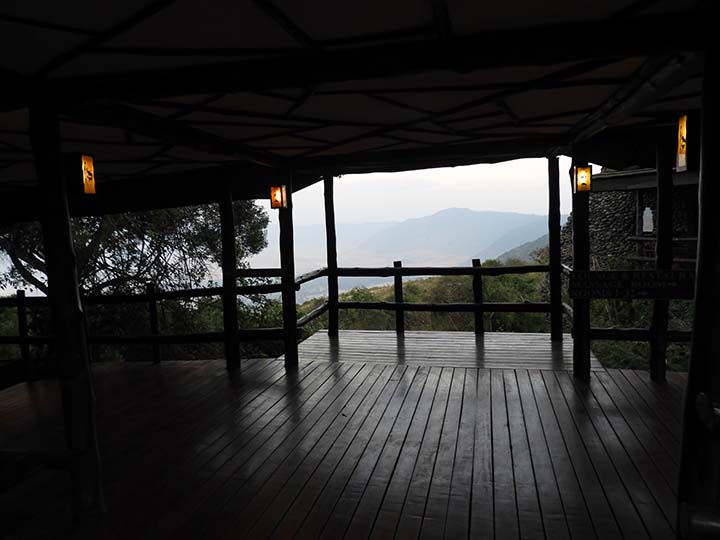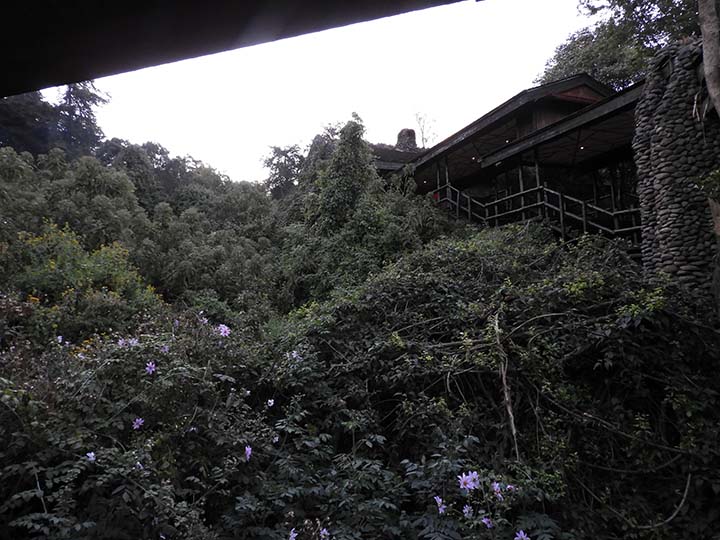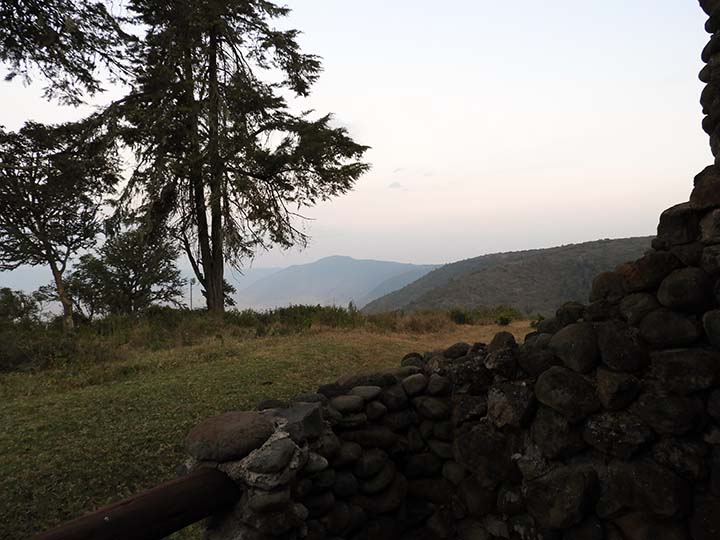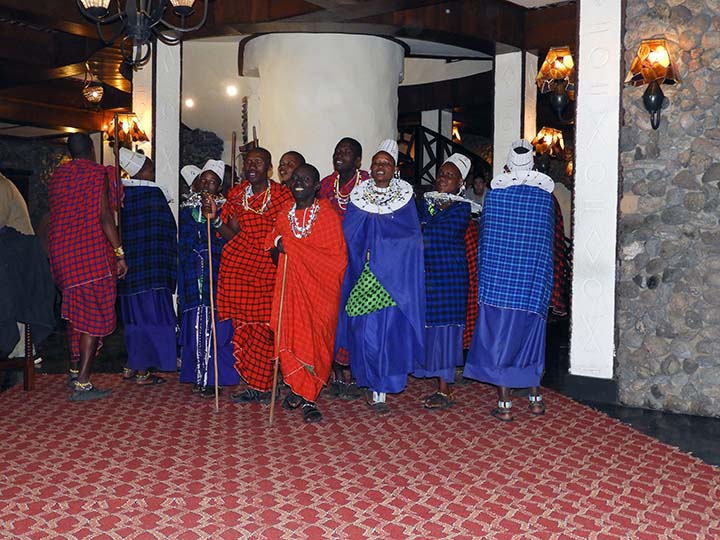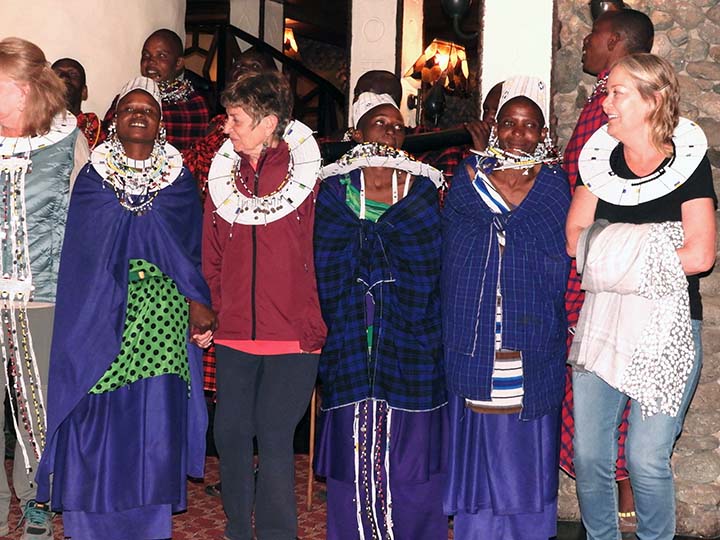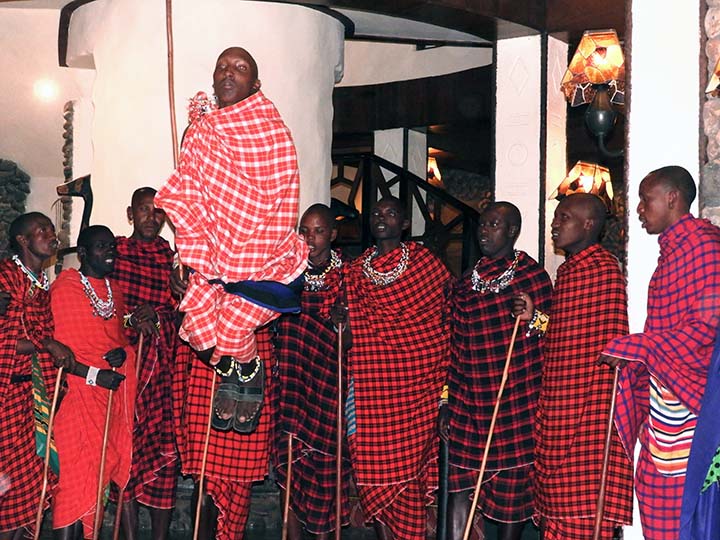|
Kip says that in the past his tours would drive all the way from Amboseli to Ngorongoro in one day, which was just a killer drive. So now they stop in Arusha to sleep before finishing the trip, and I have to say I think that's a great idea.
I mean, who wouldn't want to stay at a place like this?
Nice pool and everything.
But I didn't have time for a morning swim. We hit the road out of Arusha early in the morning, headed for Ngorongoro Crater.
And for the first time, I think, I'm pretty sure, Road Scholar took us to a touristy place, an art gallery, where we were invited to spend money. I got a lot of this on cheap tours to places like Turkey and Italy and India, but I didn't expect it to happen on a Road Scholar tour. The art was fine, I guess. But still....
I just stepped outside and waited til the misery was over.
Those are our vehicles for our time in Tanzania. Toyota Land Cruisers. Pretty nice, actually. I learned later that they began life as Toyota pickup trucks and some company in Africa removed the pickup bodies and replaced them with these, which are better suited for tourist safaris. You could see the welds under the paint inside if you looked carefully. They were spacious and comfortable and with the lids raised they were perfect for viewing the landscape and the animals.
He has a stick.
And so does he.
Even the little boys have sticks!
They come in handy when you're herding cattle.
And when you spot nosy tourists.
The volcanoes went dormant a long time ago, but the evidence of eruptions is all around.
I don't know, I can't explain, but I took a picture anyway. Straight outta...Copton?
Hi yourself!
Kip told us that the enclave over there under the trees is run by a big deal Maasai tribal chief. He has like 27 wives or something and uncounted children and grandchildren. We didn't stop by and knock on his door.
We just shot pictures from afar with our telephoto lenses. Peeping tourists. The building with the green roof is the school for all the kids.
That tree is called Adansonia Didgitata, or the Baobab Tree. Weird looking, right? Like it's stuck in the ground upside down?
Kip very helpfully explained how this came to be. See, a long time ago the baobab tree was enjoying life in Heaven and everything was great as far as it was concerned but the other plants and animals kept complaining to God that the baobab was drinking all the water. Well God gave the baobab a warning, but the tree didn't listen, so God just smacked the baobab out of Heaven and it fell to earth and landed upside down, and sure enough, just look at it there, upside down in the ground. Makes perfect sense, don't you agree?
Even though the baobab is sometimes called the "dead rat tree" (because, well, just look at the fruit hanging there), it's really an important and useful plant in this arid region. It has traditionally been valued as a source of food, water, health remedies and place of shelter.
I should look this splendid when I'm out for a walk.
A kid and his kids.
What is that lump of mud over there by the side of the road?
Termites built this? You've got to be kidding.
Yes, really, termites. They'd like to dig their nests down but they run into solid rock, so they have to build up.
And they're very particular about how they do it. In order for the eggs to stay healthy and hatch, they have to keep the nest at a specific temperature . So they design a system of vents to draft the air into and out of the nest, and they close or open the vents as needed. Clever little things, right?
Some local kids wondered what the tourists were so interested in.
I mean, who in his right mind would stop by the side of the road to have his picture taken beside a pile of dirt?
Crazy Americans.
There were termite mounds all around.
Is it easier to tote buckets of water by lugging them by hand or balancing them on your head? You tell me.
Those are sisal plants and the tree-like structures that grow from them are the flowers. They look very much like agave plants which also are found everywhere around here. Agave/Sisal: similar but different. Sisal is the oldest commercial cash crop still in survival in Tanzania. In 1893 visionary German Agronomist Dr. Richard Hindorf introduced the crop into the colony. The plant Agave sisalana was smuggled into Tanganyika from Yucatán, Mexico in the belly of a stuffed crocodile. Only 66 plants had survived the journey but it was commercially viable to start the industry. The country's warm and semi arid climate was perfect for the plant and production in the colony grew exponentially. The plants fibers were mainly used for the production of ropes for the German naval fleet and sacks to export other agriculture products from the colony. This success story began to grab the attention of the other European powers expanding their navies and the industry expanded to the neighboring colonies of modern-day Kenya, Mozambique and Angola.
Bicycles are a great way to transport loads from here to there. Firewood? Sure.
Bananas too.
Speaking of which, at the next potty break Kip treated us to some of the local red bananas.
They look exotic.
But they just taste like bananas.
Potty break pelicans.
Now this should be interesting. We're entering Lake Manyara National Park. It's a protected area in Tanzania's Arusha and Manyara Regions, situated between Lake Manyara and the Great Rift Valley. It is administered by the Tanzania National Parks Authority, and covers an area of 125 sq mi including about 89 sq mi lake surface. More than 350 bird species have been observed on the lake.
There's one now! A silvery cheeked hornbill, I think. Marsha?
Uh, oh. There seems to be a convocation of blue monkeys out here in the road, and some of them appear unhappy.
I wonder what that was all about?
Lots of birds. They look like seagulls to me, but I dunno. Marsha?
Some kind of eagle, maybe? I'm going to go with Martial Eagle. Marsha?
That is a dik dik. According to Wikipedia, dik dik is the name for any of four species of small antelope in the genus Madoqua that live in the bush lands of eastern and southern Africa. Dik-diks stand about 12–15.5 in at the shoulder, are 19.5–27.5 in long, weigh 6.6–13.2 lb and can live for up to 10 years. Dik-diks are named for the alarm calls of the females. In addition to the females' alarm call, both the male and female make a shrill, whistling sound. These calls may alert other animals to predators.
Baby baboon hitches a ride.
They're all smiling for the camera.
This vehicle's pop-top makes it easy to keep watching the woods. You never know what strange creature you may see next.
This blue monkey looks happier than the previous ones we saw.
He's downright docile, having his morning snack.
Elephants!
Wrinkly elephants.
Happy wrinkly elephants.
But don't get too close.
You might scare them away.
See?
Baboons just grow on trees around here.
On the ground, too.
Spoonbills. Right, Marsha? See, I did pay attention occasionally.
Duck? No, I think it's an Egyptian goose. What do you think, Marsha?
Cape buffalo. That one I know.
Oh, I don't know. Some kind of long-beaked bird. Marsha?
Now this is easy. Those are hippopotami. Hippopotamuses. Not as easy as I thought.
But it's an easy life.
Out here in the swamp.
When life is this good it's hardly worth coming up for air.
The birds think he's a big rock.
He doesn't care.
Look! They built an overlook for the tourists!
With a telephoto lens you can see storks way over there. Those are storks, aren't they Marsha? And certainly an Egyptian goose. And up close, are those spoonbills with all their spoons buried in feathers?
A lot of animals are happy to call this wet spot home.
And a lot of tourists are happy to come by for a visit.
Donna and Marsha and Jim and Kip are tracking down the animals.
Don't give up, guys.
You might miss a warthog.
Or a vulture. I know a vulture when I see one, don't I Marsha?
Just look at the waterfowl.
Not so wet over this way, though.
Let's have lunch!
Our driver Mohammed (Moody) is ready to eat. And so is everybody else.
Wow...the hotel packed a big lunch. I couldn't eat it all, not even that delicious quiche.
But if I dropped any crumbs, some pretty birds were eager for cleanup duty. Why do we have sparrows for this kind of thing? Why can’t we have pretty birds to nibble our scraps like they have in Africa? This is a red-cheeked cordon bleu. I found it in Google images. Aren't you proud of me, Marsha?
We didn't drop a lot of crumbs.
Marsha tried to convince me this is a starling.
A superb starling, to be exact. But I've seen starlings before and they're just ugly black. Right, Marsha? (Marsha replied, "You need to get to know more starlings.")
Is that impala glaring at me?
In more ways than one this trip has turned out to be a first for me, as I'm not accustomed to Road Scholar taking me to tourist traps. But here we are at a lavish emporium that specializes in tanzanite. What's that, you ask? Well let me tell you: Tanzanite is the blue and violet variety of the mineral zoisite (a calcium aluminum hydroxyl sorosilicate), caused by small amounts of vanadium, belonging to the epidote group. Tanzanite is only found in Tanzania, in a very small mining area (approximately 4.3 mi long and 1.2 mi wide near the Mirerani Hills. And now you know.
It's very pretty, great for jewelry, and can get a little expensive. Here's a picture I downloaded from the internet. They're asking over $53,000 for this particular gem.
Did I need any Tanzanite jewelry from this tourist trap? No, I did not.
Let's hit the road.
This is typical of the towns we passed through.
Many houses sport windows and doors; others don't.
The architecture sometimes reminds me of African villages I've seen in the movies.
I think whenever I'm out walking from now on I need to carry a big stick.
It's another National Park! Actually, it's the Ngorongoro Conservation Area, a protected area and a World Heritage Site located 110 mi west of Arusha in the Crater Highlands area of Tanzania. The area is named after Ngorongoro Crater, a large volcanic caldera within the area. The name of the crater has an onomatopoeic origin; it was named by the Maasai pastoralists after the sound produced by the cowbell (ngoro ngoro). Wait, what? You thought cowbells went "ding-dong?" Silly you.
There was a baboon welcoming committee just outside the gate.
They offered grooming demonstrations to those of us who were interested.
Actually I think tourists bore them.
Based on fossil evidence found at the Olduvai Gorge, various hominid species have occupied the area for 3 million years. We're about to join them.
There it is: Ngorongoro Crater, the main feature of the Ngorongoro Conservation Authority. It's the world's largest inactive, intact and unfilled volcanic caldera. The crater, which formed when a large volcano exploded and collapsed on itself two to three million years ago, is 2,000 feet deep and its floor covers 100 square miles. Estimates of the height of the original volcano range from 14,800 to 19,000 feet high. The crater floor is 5,900 feet above sea level. The crater was voted by Seven Natural Wonders as one of the Seven Natural Wonders of Africa in Arusha, Tanzania in February 2013. The Ngorongoro volcano was active from about 2.45 to 2 million years ago.
Now that is one big volcano.
We're going down there tomorrow.
And I can't wait.
In the dry season everything gets covered in dust. Even the tourists.
But they seem happy enough. Let's see...there's driver Moody, Bill, Myras, Kathy, guide Kip, Jim, Donna, Marsha, Mandy and driver Kir Wa.
This was the brilliant team that took great care of the Road Scholars in Tanzania. I never got to know Kir Wa there on the left, as he was the driver of the vehicle I never rode in. But he gets high marks from Donna and Jim as he stayed behind with them for a couple of days while Donna was ill and he made sure they missed none of the important sights as they were catching up with the rest of us. Mohammed, or "Moody," in the middle drove Kathy, Myras and me everywhere in Tanzania, and he was charming, engaging, knowledgeable, witty, always aware, and ... I could go on and on. Moody was great. And then of course there's James or Jim or Kip Kiptoo, take your pick, people call him lots of things. I call him a fantastic guide and I'd travel with him anywhere. Road Scholar, if you're reading this, I want you to know you have a great team here.
We learned that the idea of turning Ngorongoro Crater into a nature preserve came from a German family, father and son. Michael Grzimek (12 April 1934 – 10 January 1959) was a West German zoologist, conservationist and filmmaker. He was the second son of Bernhard Grzimek, a renowned German zoo director, zoologist, book author, editor, and animal conservationist in postwar West Germany. Michael was instrumental in assisting his father in vast surveys of wildlife in the Serengeti, with special emphasis on wildebeest migration. He was killed in an aircraft accident in 1959 when his single engine plane collided with a vulture. He was buried the same day on the top of the Ngorongoro Crater. Later the government of Tanzania erected a stone pyramid over his grave. Bernhard Grzimek was buried there after his death in 1987. Michael's survey, basically finished by the time he died, was the reason for the enlargement of the Serengeti National Park. Both men are still held in high regard throughout the Serengeti.
Now we have reached our home for the next couple of days, the Serena Lodge. I had to move. The fire was beautiful, but much too hot.
The Road Scholars enjoyed gathering by the fire, but not too close.
Serena Lodge is a very nice place.
With some great views of the crater.
A dramatic setting.
The view from my deck was just incredible.
But that's not all! For pre-dinner entertainment we had Maasai dancers.
The women wore disks around their necks and they really knew how to shake that thing.
They even invited some volunteers to join in.
Just watch this.
The men liked to jump.
And sing. They sounded just like ... African tribal singing on TV.
Apparently jumping proves their strength and maturity.
And boy could they jump.
|

